#i DO really like the cinematography; i think it's shot really interestingly
Explore tagged Tumblr posts
Text
l.onglegs is....... kinda mid, not gonna lie?
#♔ ⋮ 𝐥𝐢𝐟𝐞 𝐢𝐬 𝐚 𝐠𝐫𝐚𝐯𝐞. ( out. )#tbd.#i got around to watching it bc everyone was singing its praises and i like.#don't???? care for it??????#i DO really like the cinematography; i think it's shot really interestingly#and there ARE aspects of it i enjoy like the suspense and whatnot#but like......... i just can't take it seriously..........#and it's very slow; which normally i'm a fan of but this feels like a slog#everything's supposedly happening and yet nothing is happening?
12 notes
·
View notes
Note
don't start me thinking of the cinematography that could happen with the shots and timeframe of youth selflessly and homoerotically sucking infected blood from old man with power over him vs the reverse happening with dracula and jonathan, or everything you could do with the entire age dichotomy (see also youth forced to suck infected blood wrt dracula and mina, old renfield vs young maid lucy in willingness and unwillingness and their fates, etc etc)
There is a part of me that thinks they could use a religious perspective for cinematography, like Van Helsing being the savior and Jack being his disciple. The act of sucking the gangrene could look like kneeling and kissing his hand. But I also like subverting it into something more reciporated.
I was thinking about other famous cases of people sucking poison out of a wound. The only prominent example I could find is Eleanor of Castile saving her husband, King Edward 1, from a poisoned arrow by sucking the affected blood out (which may not even be true). This painting by Angelica Kauffman depicts an atmosphere of intimacy, love, as well as urgency and danger. Also interestingly, the couple are both on the bed, bowing their heads to each other, which gives the impression they are equals.

I really like the idea of the same kind of styling being used to show Dracula feeding on Jonathan, or later Lucy, with more stark and dramatic shadows! Of course, Dracula would have to be on a much higher ground, or larger than life to show how powerful he is against his unwilling victims.
#dracula daily#dracula (novel)#abraham van helsing#jack seward#thebibi answers#helward#eleanor of castile#idk I suddenly went to look for historical art references
30 notes
·
View notes
Text
My Journey to You Ep. 23 visuals: Ravens only belong to winter
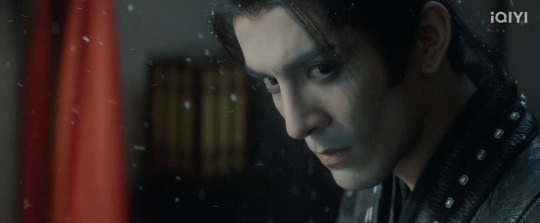
Say what you will about this show's writing for the lead characters (particularly Gong Ziyu and Shangguan Qian), but you can't deny MJTY's writing when it comes to its minor characters. I came to care for so many of them with just a few scenes, and I think a lot of that is due to the show's visual storytelling, which is used to reinforce its themes in an almost brutally efficient way.
Nowhere is this truer than with Hanya Si and the show's use of shadow and light to communicate his story.

The death and violent secrecy surrounding Wufeng have been etched so permanently on Hanya's soul that he can't escape its darkness. He no longer sees himself as a man, but as something less than:
"[Ravens] know there are hunters and traps in the dark forest, but they can never fly to the light. They've been eating dirty mice and rotten meat since they were born. Even their screams are fearful and ferocious. They can only live in the dark and beneath the sunset."
This is communicated over and over again with how the show physically positions Hanya either against or away from light for most of his scenes. Whether at the Wufeng headquarters or in the Gong residence, he is placed in the shadows--even as other characters stand in or move toward light.

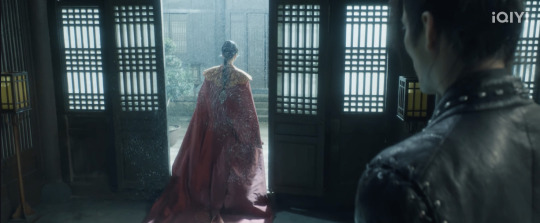
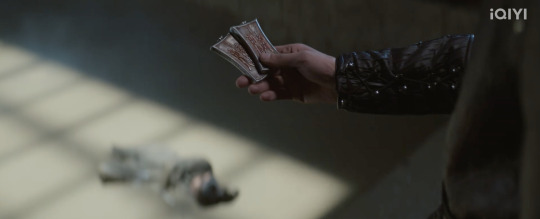
Interestingly, he's really the only assassin we're officially introduced to who is shot like that. For example, check out the scene below where he, Hanya Qi, and two of the wangs meet. Even though the overall scene is dark, Hanya Si is the darkest as he's positioned furthest away from the overhead light. And in the final showdown at the Gong residence, the other assassins fight during the day (which Hanya Si has never been portrayed as doing until his final scene). Unlike the others who revel in killing their targets in broad daylight, Hanya has become so consumed by his sins that he doesn't believe he's worthy of existing anywhere but the darkness.
(Side Note: I found it telling that the last Wufeng attack that killed Gong Shangjue's mother and brother also happened during the day rather than at nighttime. There's a startling brazenness to Wufeng's violence.)

The exception to this pattern, of course, is when Hanya is shot with either Yun Weishan or Yun Que. Those moments with his protégés are the only times he embraces his own humanity and dares to step out of his self-imposed prison to provide care in whatever misplaced way he can. It's only in those scenes that his face becomes awash in direct light.
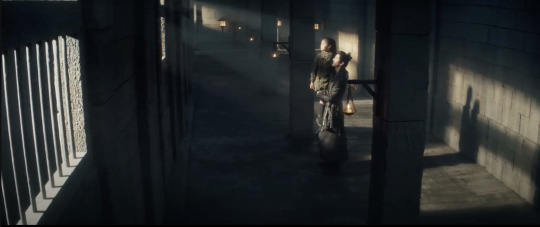
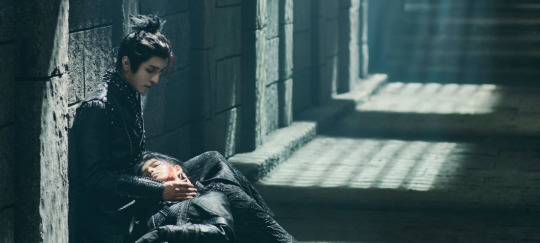
So when Hanya decides to help Weishan fight Ziyi, it's fitting that the show commemorates this character-defining moment by drenching the entire screen in sunlight.
I absolutely love this shot with the lens flare. The show rarely uses this camera effect in its outdoor cinematography so you can feel the foreignness Hanya must have felt walking into the early morning light to face his destiny. The blown-out sky is wondrous and almost overwhelming in its brightness.
And it also seals his fate because we know ravens can never fly to the light; they can only live in the dark.
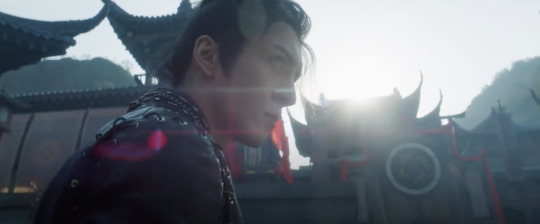
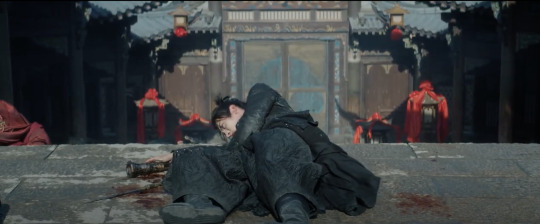
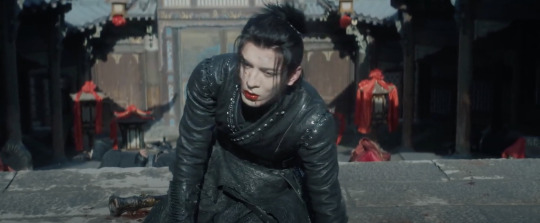
The mirroring of Weishan and Hanya’s first sunset and last sunrise together nearly took me out. Director Edward Guo clearly likes reusing certain compositional elements to establish his characters, and with Hanya's scenes that repetition not only lends itself to a feeling of tragic inevitability but also freeing closure.
"I watched the sunset so many times with you. This time, I can finally watch the sunrise with you."
What a perfect way to send off this character.
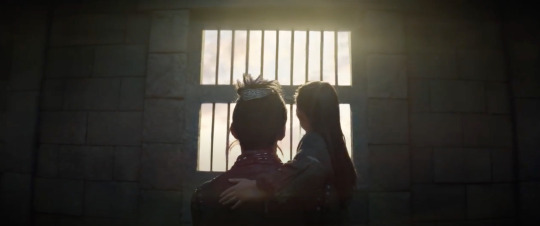

114 notes
·
View notes
Text
Movie Review | Sorority Babes in the Slimeball Bowl-O-Rama (DeCoteau, 1988)
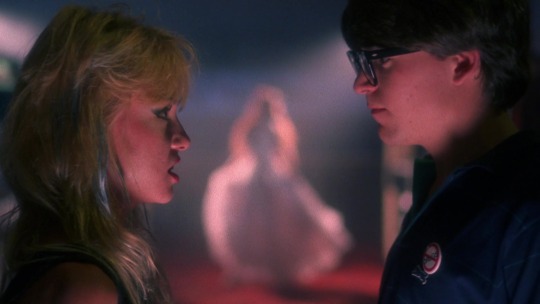
This review contains spoilers.
Not a lot to this, but if you accept that there’s a cap on how good this will be, it’s pretty enjoyable on its own modest terms. I’m no David DeCoteau expert, but this has similarities with Nightmare Sisters in that it stars Linnea Quigley, Michelle Bauer and Brinke Stevens, has a plot that relates to fratboy types and sororities and related horndog behaviour, and is mostly set in one location. When I say there isn’t a lot to this, it’s that there isn’t a great deal of incident in its eighty minute runtime, no particularly outlandish possibilities entertained as a result of its premise (a sorority prank results in the protagonists getting trapped in a a bowling alley unleashing an evil imp, who possesses some of them and sics them on the other), so really how much you enjoy this depends on how much hanging out with these actors. And I like Quigley, Bauer and Stevens quite a bit, so I had a good enough time. A bunch of stray observations:
I complained in my review of the 2021 Mortal Kombat that the digital cinematography in that movie looked dark, murky and flat. The cinematography in this movie is certainly dark, but what a world of difference it makes when these things are shot on film and some thought goes into the lighting. Because the characters are running around a bowling alley at night, it’s understandably pretty dark, but the lighting in this movie all looks like a portal was blown open from another dimension, and the impossibly bright beams that emanate from it are enough to blind you.
The imp (who is voiced with a… racially questionable cadence) grants each of the characters a wish. Naturally one of them wishes to make it with Bauer, and pretty much all the nudity in the movie comes from this scene. (DeCoteau lovingly photographs the guy shirtless in addition to Bauer in the buff.) Most of the other wishes have a monkey’s paw element (gold that turns out not to be gold, a prom dress in tatters), and the twist here is that Bauer is a bit too excited? The way the movie edits this scene it seems like it might have gone on for a long time, but the guy nervously protests that she’s going too fast for him. There’s probably something interesting here about fratboy types getting cold feet when their fantasies might actually true combined with the bluntness with which the female nudity is presented.
Early in the movie there’s a sorority hazing sequence where Bauer and Stevens are paddled on their behinds in loving closeup. I’ve never been in a sorority, because I’m a dude, but have also never been in a fraternity, but I’ve always gotten an uncomfortably sexual vibe from depictions of hazing rituals. And this movie seemingly shares my viewpoint, as the head of the sorority gets transformed into a dominatrix after she’s possessed by the imp. Again, there’s probably some overarching commentary around sexual mores that can be read into the movie that’s maybe a bit more complex than the moralizing one associates with slasher movies of the era.
The male lead of the movie is introduced watching horror movies, and announces that he’d rather do that than go spy on the sorority house, and I’ve never related more strongly to a movie character in my life. Interestingly, while his friends are more concerned with peeping on girls and getting laid, he’s the only one who actually tries to form an actual relationship of equals with a woman in the movie. Of course, that woman is a burglar from the wrong side of the tracks played by Linnea Quigley, who, as she often does, totally steals the movie. But the fact that both of these characters have motivations and ways of thinking removed from the fratboy / sorority mindset ensures that they survive the ordeal.
In the parlance of a wise man, I’ve done the research, I’ve looked at the facts, I’ve analyzed the hard data and my conclusion is that there are few things more adorable than the specific way Quigley darts her eyes and curls the ends of her lips when she breaks into a covert smile.
3 notes
·
View notes
Note
have u ever talked abt "annoying covid shot construction" aside from the cowboy bebop post? what do u mean?
hello! so there's two parts to this
the first part is one i did talk about it a bit this post. i.e. that i think the series, sometimes to its detriment, tried too hard to reconstruct shots from the anime and it messed with the pacing. live-action doesn't flow with lingering closeups, the way animation does, but i get they were trying to callback to the original. it just doesn't make for enjoyable viewing when u don't know the visual reference, yet constantly feel like you're being nudged too. i got used it and still enjoyed myself, but it was still tedious and alienating at times.
part two of bebop's awkward shot construction isn't unique to it at all, but a necessary measure in during the pandemic (pre-vaccine) which is that shots were/are being constructed so that actors maintain physical distance wherever possible. i'm sorry to point it out cos its a bitch to unsee, but its obvious this was filmed during no-vaxx covid because unless its necessary these people are always either a) standing apart, b) sitting with long tables between them or c) shouting accross spaces, etc. social distancing rules mean that shots have to be constructed in a way that makes that gap seem natural/deliberate, or not there at all. succession has done this very interestingly, using it stage physical powerplays. but with live bebop it doesn't quite work cos the vibe is meant to be that these people are crammed into this spaceship, living in eachother's pockets in a crowded galaxy and it doesn't work because of how the actors have to be spaced.
of course, i am not being super harsh on it because i would obviously rather workers be safe. no one should catch covid for cinematography. i'm just acknowledging the impact it has on the mise en scene, at least for me. but like i said, i still had a great time watching, and some things can't be helped and i definitely think bebop made the best of what would have been a really difficult shoot.
6 notes
·
View notes
Text
MVNALYSIS: GOD’S MENU by STRAY KIDS
Hello friends, seeing as 2020 is going down in flames anyways, there seems like no better time than to start my MV Analysis series, MVNALYSIS. Storytelling and cinematography are both important but the technical aspect is definitely more interesting to me. If you’ve followed me for any length of time, you’d know how often I yell about a good lighting scheme so this is just an extension of that.
There have been some great MVs this year but the one that really lit my fuse and prompted me to do this is God’s Menu by Stray Kids. If you haven’t seen it yet, go watch it first then come back. This is very long so if you’re not really interested in the technical aspects of music videos then I would definitely recommend scrolling past.
1) The Cyberpunk-Anime Intro tracking shot. That flourescent-neon title card reminds me of cyberpunk aesthetic, especially if you’ve seen the trailer for Cyberpunk 2077. I really love title cards because they remind me of old movies and cartoons. To throw it up so nonchanlantly immediately sets the vibe and subconsciously triggers your mind to think about when you last saw something like that, be it a video game or anime or a movie. They use it a lot more often than other groups and I never noticed until I went back to watch a few of their videos for this post.
The Intro to God’s Menu is both a sonic and visual assault. It’s so fcking good that I am almost sad I will never get to watch it again for the first time.
That tracking shot for Changbin is just beautiful perfection because it has three levels of depth and a very controlled use of blocking. The deepest level is the chaos in the background, the main level is Changbin and the most superficial level is the one closest to the camera, with the marching band player. Interestingly, the movement and speed of each level progresses in descending order: the background is crazy busy, Changbin is moving through at a controlled pace and the marching band player is almost still, like a sign post to reiterate the depth of field.
There are a few really famous and amazing tracking shots, so I’m just going to link them here if you are interested in camera work: Atonement (legendary tbh), 1917 (deserved the cinematography Oscar), Ava Adore (you can see the track they used for the whole video) and the Baby Driver introduction has one of the best tracking shots but I won’t link to it out of respect for people who might be triggered.
Sometimes you watch something and you don’t know why it’s so cool. Well, this is why it’s so cool. This is why some MVs are so interesting to re-watch and why others have no re-watch value at all.
2) Transitions and editing. Oh boy. The fcking transitions. Sometimes people think of them like a cheap trick in the vein of a horror movie jump scare but when you see a good transition, 'cheap’ should be the last word you think of. All the transitions are worth mentioning: Changbin seemingly changing the frame with his hand, Han’s mid-choreo transition and Hyunjin’s forced perspective to mimic the spotlight. I suppose they are are little flashy and tricked-out but it doesn’t change how cool they look. The video editer deserves all the credit for this one.
It’s seems obvious but I can’t ignore the stop-motion DuDuDuDu editing either. It does exactly what the music does in that moment: it’s jarring and abrupt and literally like shots fired and bleeding red. Sometimes literal interpretations are cringey and don’t work but sometimes they work so well you wish everyone was on this level.
A more subtle transition is one that I don’t see a lot of people talking about but it’s when the music shifts from the heavy rap to the smoother vocals. The first time it happens we went from the dark enclosed confines of Han’s kitchen rap to vast open air of the cars racing. The smooth flow of the vocals is echoed in the smooth silent roll of the car tires and then the smooth choreo from Bangchan with that bright God ray lens flare. It’s just like a smooth smooth smooth flow of water after total chaos and that’s exactly what the music is trying to do: the rap is a spicy meal, the vocals are a glass of cool water. Seriously, this MV is so well thought out and well planned. It’s like the director actually listened to the track. What a crazy notion, heh.
3) Robot Camera. If you’re not sure which part I mean, it’s basically during Han’s rap, Felix’s 5 Star Michelin part and the subtle camera tilt for the group choreo. You can see it in action in their ‘Making Of’ video. You’ve probably seen this used before, most notably on Jungkook for DNA but I think it was made really popular in music MVs when Kendrick Lamar did it for Humble. Everyone is using it now but I still love it. No human can film with that precision and it’s seriously cool use of tech. I like that they didn’t overuse it though because it would’ve felt too repetitive. Restraint? In Kpop? Hell really has frozen over today.
4) The colour and lighting. It’s generally really well lit and coloured but the most remarkable thing to point out here is that God’s Menu has only four sets. It feels like it has some meat and depth to it because they used those four sets to their full capacities. In contrast, I think I counted 9 sets for GOT7′s ‘Not By The Moon’ and let’s be honest, they were all kind of wasted.
The scrapyard set is used four times with four different lighting schemes and you barely notice how repetitive it is because they all look so different. The garage scene is my favourite example of good depth of field because they’re in a tiny confined area for choreo but it doesn’t actually feel tiny or confined because of the huge open grandstand in the background.
Also. It’s rad how the video goes from day to night. I didn’t even notice until the third or fourth re-watch.
5) Kendrick Lamar. I just wanted to spend a little time on this point because I hear and see his influence on God’s Menu. Obviously, Kendrick doesn’t have a patent or copyright on use of RoboCams but the main backing track is very Humble-esque and the DuDuDu reminds me of old KL. It’s a little grating tbh but the producer at least showed some restraint with it. Any more of the DDD part and it would’ve been too obnoxious to listen to.
6) Styling. I really love these black outfits because they look like a cross between a karate uniform/dobok and black chef aprons. I wasn’t really sure why they went with the racetrack imagery but there is something about this entire MV that reminds me of anime/manga...and then I remembered that Initial D existed. If you’ve never heard of Initial D until now? You’re welcome.
Oh and Hyunjin’s hair. Damm.
7) Bias: Okay, I’m Australian and I used to live in Sydney so part of me has always been invested in Chris and Felix. But. I have to be straight with you all, that tag-team of Changbin and Han is insane. Insane, I tell you! I wish I could hear that rap intro again for the very first time. It’s like when I heard Mingi’s rap in Wonderland for the first time. Some things are just inexplicable.
8) Conclusion: This is one of the best MVs JYPE has ever made and it’s not even story driven. The modern tech and insane editing is truly next level and I hope people appreciate the work that went into it instead of just seeing it as another flashy kpop video with no substance just because it’s not “deep and meaningful”.
#MVNALYSIS#stray kids#God's Menu#Felix lee#Bang Chan#hyunjin#Han#Changbin#Jisung#he gets two tags#Minho#Seungmin#i.n#i should write his actual name#but i'm tired now haha#text#music video#there are lots of links in here#i like to analyse stuff i guess#there just hasn't really been a lot of MVs that made me want to write#i'm really looking forward to the new CIX mv#anyways#i should've watched the Making Of video first hahaha
11 notes
·
View notes
Text
Werner Herzog On Unlocking the Secrets of the Universe…from Earth
https://ift.tt/eA8V8J
There may be nothing more pleasing than watching a room full of scientists erupt in glee as the probe they spent hurtling into space years prior finally touches down on a moving object in the farthest reaches of space. The information and material that the probe will send back can hopefully answer questions of the universe we’ve been trying to ask since the beginning of our existence. Since before humans even walked the earth, however, the dark blanket of the sky has been depositing meteors to our world that hold important answers of the unknown.
The new Apple TV+ documentary Fireball: Visitors from Darker Worlds by the filmmaking team of Werner Herzog and Clive Oppenheimer takes a look at the history of meteors falling to Earth, and the impact they have on both science and our cultural roots. We spoke with Werner and Clive to discuss the importance of documenting these phenomena and the process of bringing it to audiences in an informational, entertaining package.
DEN OF GEEK: In these types of projects, obviously you want to be able to teach people and show them something they may not know; but is there a need to balance wanting to feed your own curiosities as well?
Werner Herzog: It’s only curiosity. If we wanted to teach somebody, we would be teachers. But it was always clear we must not be didactic. This has to be entertaining, there has to be that excitement of science. It has to be the awe of what we are seeing, then we are on the right track.
Clive Oppenheimer: It’s show business. And cinema.
But in the same breath, obviously we’re in a time right now where science is somehow under attack, it’s more important that we get these things out there for people.
Clive Oppenheimer: I think with the attack on science, this is probably unstoppable and it serves various agendas and vested interests. You know in some ways I’ve seen it, I’ve seen how it operates, and I think we just have to set this aside. We know what we’re about and we know what we’re trying to do with these films. Above all, it’s to make hopefully a lasting piece of art, which brings together music, cinematography, and extraordinary people and locations and ideas of the human imagination.
Talking about cinematography specifically, I think it’s interesting that there’s so much more being captured now because people have cameras in their hands all the time. It’s so interesting to know that we’re catching these physical occurrences like the meteor in Russia because there’s a whole country of people worried about insurance fraud and using dash cams.
Werner Herzog: Well, in Russia it’s not insurance fraud. The police would try to extort money from you, stopping you saying you ran the traffic light and extort money. But that all dates back to Yeltsin’s time when police were not properly paid, when pensions were not paid, when school teachers were not paid. So it was a time of catastrophe for Russia. That’s over, but the dashboard cameras remained in the cars. You see them everywhere.
We were lucky that an event like this was filmed. We were asked by some people who were interested to be in production if we had footage. Yes, but we need this kind of footage in 4k and all there is are such lousy videos from Russian dashboards. And I said, fine, let’s sit with a camera for 800,000 years on Mount Rushmore… maybe we will be sponsored by someone [laughter]. Of course, it’s very fortunate that we have this dash cam footage.
Obviously, the empirical evidence that someone is looking for is coming from these objects as they are studied. But I’m wondering if there are also comparisons that can be made from actual meteors to the space junk that may have fallen back into orbit.
Clive Oppenheimer: I mean, space junk is…I would see this as quite a different kind of phenomenon. There are now archaeologists studying space junk, which I find very, very interesting in itself. But with meteorites we’re looking at things that are four and a half billion years old. So, you know, reaching back to the earliest times of the solar system indeed there are even presolar grains into stellar grains that date before the formation of our own services and that are found in some of these meteorites.
We’re reaching way, way back in time and we’re also looking at objects that have had, and have huge cultural significance for us. One of the earliest recorded falls of a meteorite was in Japan 1200 years ago. The stone is now a relic in a Shinto temple in Nōgata, Japan. Every five years it’s processed through the streets and this fascinates me just as much as the revelation that they’re carbonaceous meteorites full of amino acids and sugars and other organic molecules. So it’s a very rich topic to dig into.
In regards to the organic molecules, when it came to Jon Larsen’s micro meteorites, I remember him saying that they’ve never found one that was exactly like the other. Or that the compounds found in each one never repeat; but in essence, somewhere that has to be something that broke up and split apart…there has to be another one out there to compare it to right?
Werner Herzog: Because I think some of them were always dust, and only at some time in the history of the universe– billions of years ago–they coagulated to solid larger bodies of metal. And I think about what Jon Larsen, the jazz musician turned scientist says, “Dust is the currency of the cosmos.” Some of them never break up; they were always only dust. And that’s the currency of the cosmos
Obviously, it’s going to be easier to study something that lands on a certain type of terrain, but I’m surprised we didn’t hear a lot about something that possibly may have been found under the ocean, or that created craters in the ocean itself. Are those existent?
Clive Oppenheimer: Yes, almost certainly. If you think about just the probability of where a stone is going to land, most of them are falling in the oceans. And so for sure there will be the down there, but you’ve also got to think of the size of a stone that is going to leave a crater on the ocean floor if it’s traveling through two miles of ocean.
Werner Herzog: You can say that you wouldn’t see anything, but of course in the Yucatan Peninsula you have a crater that’s 200 kilometers in diameter. Part of it is in the ocean, which I think didn’t exist like that before, 65 million years ago.
Clive Oppenheimer: Interestingly, the micrometeorites – this cosmic dust that Jon Larsen looks for on roofs of sports arenas and elsewhere – this was first discovered in the late 19th century during what’s regarded as the first oceanographic research cruise. They dredged up sediments from the deep Pacific, and they found these little spherical particles which they realize were extraterrestrial. They’re there because they’re in areas of very, very low sedimentation from the continents that are a long way from where erosion is washing land sediments to the seabed. So they concentrated there.
They’re found as well in the icing remote parts of Antarctica. The remarkable thing that Jon Larsen did was he said, “Well, this dust must be everywhere. It must also be in car parks in New York City and on the roofs of shopping malls. I’m going to have to sift through an awful lot of bird excrement, but I’ll find it.” He spent five years doing that till he found his first particle but now he’s got thousands of them and found out how to discriminate between them. It’s extraordinary, it’s a whole new branch of science.
Did you look into anything interesting that didn’t make it into the film?
Werner Herzog: We have something that made it halfway into the film, and that’s a black stone in Mecca, the holiest site of the Muslim world. Neither Clive nor I are Muslims – we’re not allowed to set foot into the city of Mecca. Of course we respect this, and we tried to organize with this young, very gifted Saudi filmmaker who had filmed before in Mecca. We gave him very precise instructions, there’s a wonderful shot in the film, but we have it only for three seconds. We needed it for 30 seconds but he never got the full permits to do it and we were already into editing. So, if we had to rely on cell phone footage, which was shot by one of the pilgrims.
Clive Oppenheimer: There’s nothing in the way of something being left out of the film but there are other topics (I would have liked to cover). There’s the whole year of asteroid mining; of going out there and coming back with rare earth elements and precious metals. And there are outfits that are seriously looking into the logistics of that. There’s a Japanese company that does – let’s say you know you really want a fancy wedding, well why not have a meteor shower for the reception? So they are dropping little bits of dust from satellites to make your very own meteor shower.
Werner Herzog: Sand falling to create a meteor shower for the bride [laughter].
Clive Oppenheimer: I’d have loved it if we could have done that.
Werner Herzog: The Japanese have the most wonderful, spectacular idea when it comes to that.
Clive Oppenheimer: Great for the premiere of the movie.
What is your dynamic like when you enter into these projects? Do you approach it as Clive having a certain expertise and that Werner is kind of acting in our place as the novice – to ask the questions the audience may have?
Clive Oppenheimer: We work very closely and we’re in frequent contact throughout the pre-production, as we’re thinking about locations and crew, and during the editing. But we bring different skills to it and I think for me it’s neither a disadvantage or an advantage that I don’t have a training in fine arts or in filmmaking. So I can say, or suggest possibly outrageous ideas, and generally with Werner they don’t meet with negative reactions. Werner also has a very different approach.
Werner Herzog: The beauty of life is that I never had any training in fine arts and filmmaking either. I never went to film school.
That may be true, but so many people revere your films. And even though you are still making narrative films, a lot of people now know you for these documentaries.
Werner Herzog: It’s an abomination because much of my documentary filmmaking is feature films in disguise. And what will remain of what I have done will be two things. The book that I have written–the prose texts is one thing. Like, Conquest of the Useless or, Of Walking in Ice. Then there are the feature films; Aguirre: The Wrath of God, The Enigma of Kaspar Hauser, or Bad Lieutenant: Port of Call New Orleans…anyway.
There are still throngs of younger audiences now who just know your voice from various cartoons you’ve lent it to (American Dad, Rick and Morty), and of course because of things like The Mandalorian. It’s almost like you’re creating another version of yourself.
Werner Herzog: No, it’s not another version of myself, It’s just me doing professional work. I’m a professional man and I do what I’m good at. I would never be in a film as an actor in a romantic comedy. See, I gotta play the badass.
cnx.cmd.push(function() { cnx({ playerId: "106e33c0-3911-473c-b599-b1426db57530", }).render("0270c398a82f44f49c23c16122516796"); });
Clive Oppenheimer: I’ve lost sleep, you know, ever since I saw him in Jack Reacher. That was terrifying.
Fireball: Visitors from Darker Worlds premieres on Apple TV+ on Friday. Nov. 13.
The post Werner Herzog On Unlocking the Secrets of the Universe…from Earth appeared first on Den of Geek.
from Den of Geek https://ift.tt/36ASbJE
2 notes
·
View notes
Text
The Secret Garden - weird steampunk version
That was... surprisingly good. Not amazing, but a lot better than other adaptations I’ve seen.
Ms Medlock seemed sympathetic. In other adaptations, she’s this strict, severe woman who just barks orders and is cold. Most of the time in this, she’s like that, but you see moment’s of humanity and she’s only trying her best.
Martha is great. She’s snarky at Mary at the beginning but then softer later, and I like that she takes a more active role in bringing the garden back to life.
The recurring thing with the handshake between Mary and Martha is sweet too.
Dr Craven is a great villain and there was a twist which I wasn’t expecting that I didn’t screenshot.
The killing of the ROBIN!!! The ROBIN’s been this fun drone buzzing around in the background and then he’s dead. He’s a robot, so he does come back, but in the moment it’s surprisingly effective.
The doll is sweet.
Mary stopped being unlikeable very quickly. She was very full of herself early on but mellowed quickly.
Ben’s nice as a character. He was fun and brought a lot of humour to the film.
My favourite thing is Lily. Colin’s mother is basically non-existent in the book and most adaptations except for the fact that she died and that she loved the garden. A few characters talk about her but we know basically nothing except that she loved the roses. This Lily Craven is a much more active person, doing things and building things, and the garden is really her creation.
There were a number of times when they had lines that I think were lifted directly from the book, but the change of context makes them interesting. Like Colin say he doesn’t like his mother looking at him when it’s her blueprints not her portrait, and his line at the end about how he’s going to live “forever and ever and ever” when we know that he’s a robot and he definitely will.
There were some nice bits of cinematography. A lot of the shots of Mary and Dickon in the garden for the first time were interestingly done, and I like the way a lot of shots shown dust and dirt in the air.
Bits that disappointed me:
It’s a shame we didn’t get a payoff to Ben’s staff. He sets it up at the beginning with the line about him controlling the weather and at the end it looks like something’s going to happen but it cuts away. I was expecting it to have been rigged up with electricity so it could shoot “lightning” and to see it used against Dr Craven. I was disappointed that we didn’t get to see that, but I still quite like that it’s a bit mysterious.
I didn’t like Colin. I get why he was played the way he was, but I just didn’t like him.
It would have been nice to have more time on the garden coming back to life. That happened really quickly given everything else going on in the story.
The cobwebs was so obviously fake, especially in Dickon’s hideout. Less of them would have been more effective.
---
Overall, not a perfect film, but certainly deserving of more than the two and a half stars it was rated. It’s at least a three, maybe even as high as a four out of five.
One of the reviewers marked it as 1 star but said in their review that they stopped watching after 44 seconds. How can you give anything a fair rating after 44 seconds? I was expecting it to be terrible but found myself enjoying it a surprising amount. I might have to give it the four star rating to balance out the people who took one look and then rated it terribly.
1 note
·
View note
Note
Favorite movies/tv shows of 2019, and why? (Also, I really like your posts and hope you post more stuff!
Thanks so much! More posts are incoming. And sorry for taking so very long to answer this.
To be honest, I don’t watch a ton of contemporary stuff. I tend to think it’s healthier to take advantage of the great wealth of great art (or weird-but-interesting art) made in all time periods than to focus on keeping up with the present. Not that I don’t watch any contemporary things, I just don’t prioritize it in any way. So this list isn’t based on me watching everything and then picking out the best. It’s based on me watching a few things and liking some of them. But I hope that even if this list isn’t any more interesting than a list of awards ceremony nominations, I might at least have something worthwhile to say about the things in question.
Recent TV:
(I’m cheating and including TV from 2017-2019 that I watched in the last year or two, or else the list would be pretty boring and short.)
Succession (2018-present) - Maybe my favorite of the shows on this list, which is surprising to me because it’s not the kind of show I normally like. I don’t tend to care about rich people being mean to each other, or art that is glossily timely. I don’t get off on seeing the private dramas of powerful, immoral people. What I like about Succession is the sense of fragility and desperation that infuses it. It’s about the human desire for these stable institutions—families, kings, corporations—and whether or not they’re actually stable, and whether or not they should be destabilized. The whole thing is just a wonderfully rich text that has been made with a lot of craft. It’s nice to know that there are people making art that is very much about the present, and has something interesting to say about it.
Fleabag (2016-present) - The second season has gotten a lot of deserved praise, so I’m not going to dwell on its merits. It’s a complex and often moving exploration of the nature of love, whether romantic, familial, physical or divine. What makes it a truly “mature” artistic work is the way that it knows what it’s about from the very beginning (“this is a love story”) and complicates that aboutness in every single episode. It’s actually interesting to compare to the first season, which lacks the same maturity. The first season is still worth watching, but it doesn’t really become clear what it’s about until the last second, when Fleabag gives her monologue in the cafe. You keep waiting for it to get to the point, instead of having a repeated sense of anticipation about the point and accompanying satisfaction every time the point-shoe drops.
Killing Eve (2018-present) - Solid entertainment. Had a bit too much of the “contemporary TV aesthetic” for me to really love. But I’d missed genuine originality and clever writing in thriller-type stories. So it’s got that going for it. (Trying to actually define the “contemporary TV aesthetic” is a problem for another post).
unREAL (2015-2018) - I only watched the first season, and don’t feel a need to watch the rest. People tell me the subsequent seasons aren’t very good anyhow. But it was doing some interesting things. Things to do with femininity, authenticity, performance and love, and the degree to which they interfere with each other. I’m planning on talking about it a bit more in a subsequent post, along with Fleabag and the movie Weekend.
Sharp Objects (2018) - Mainly watched this and unREAL because I wrote so much about Buffy season six in the last year, and I was curious about Marti Noxon’s other shows (She was the main showrunner for that season, and you can definitely tell. Unhealthy relationships, mental illness in women, rough sex, and ideas of performance seem to show up in a lot of her stuff.). She has an interesting tendency to choose “trashy” subjects, but with a refreshingly non-cute approach to the (mostly-heterosexual) female id that I respond to. I keep trying to figure out what quality Sharp Objects had that other recent art about “women being and feeling fucked up in an artistically exaggerated way” didn’t have. Things like Midsommar, The Favourite, or Gone Girl. None of which I liked. And I think it comes down to that lack of cuteness. Watching a female protagonist furtively masturbate over the memory of a murder-shack in a way that’s not about fetishizing her? Either for a male or female or political audience? It’s weirdly satisfying.
Euphoria (2019-present) - Only watched the first four episodes or so, and probably won’t watch the rest. But it was interesting to me as a pretty successful attempt to be blatantly zeitgeisty. I like its vision of contemporary life as something full of hyperstimulus (“euphoria,” get it?). Whether that’s the hyperstimulus of porn, love, attention, validation, or actual drugs. It didn’t seem to be a reactionary condemnation of all of the above, more just a depiction of it, but since I didn’t watch the whole thing I can’t comment on its attitude with certainty.
The Vietnam War (2017) - Excellent Ken Burns as usual. I appreciated the variety of perspectives he interviewed, and I appreciated the episode dedicated to Vietnam’s history before the war started. If there’s one thing that American schools suck at teaching about the Vietnam War, it’s the Vietnamese side of things. I’m not a historian so I can’t comment on how good the history in the series is. I’m sure there are important criticisms to make of it, and like all Ken Burns documentaries he uses emotional tactics to tell the story that can at times feel manipulative in a bad way. But as someone who always wanted a more in-depth, multi-sided understanding of the Vietnam War, but didn’t know where to start, I was very glad to have watched it.
Black Sails (2014-2017) - Still haven’t seen the last season. But after watching I was honestly surprised I hadn’t heard more people talking about it. Or maybe that’s just my fault for not keeping up with mainstream writing about culture. It had some fascinating themes about the nature and fragility of civilization, and I think it would be interesting to compare to Succession on that front. Black Sails features characters on the outskirts of society. Whereas Succession features characters at the center of society. But both are about the desperation for stability that leads people to make societies—and disrupt societies—in the first place.
Recent movies:
(Sticking just to 2019 this time)
Once Upon a Time In Hollywood - What I liked about this movie is that it felt like a movie. I left it feeling like I’d had a big old cineplex experience. Which was fitting, because the movie itself was about the big artificiality of film. Throughout, there is this contrast between real violence, and movie violence, and who has an understanding of them. Cliff Booth, as a stuntperson, has a “real” relationship to violence, while Rick Dalton, as an actor, does not. Cliff can cut through a cult’s fakeness, and knows to turn aside an offer of underage sex. But although Dalton does not understand authenticity, he does understand fakeness. The point of the teenage terrorists in the final act is that none of them understand either authenticity or fakeness. They don’t get that violence is real, and they don’t get that movies are fake, which leads them to being destroyed by their own movie-inspired violence. In typical Tarantino form, the movie does have a smug-feeling nyah-nyah attitude about this theme, a feeling of “you idiot loser generation, you don’t get the seriousness of violence and you also don’t get that movies are fucking fun.” But it was a theme I found interesting nonetheless.
Apollo 11 - Unequivocally loved the cinematography. Just completely aesthetically compelling to me on every level. I would have have watched an entire Koyannisqatsi devoted to it. But I feel sort of weird saying that I liked Apollo 11 as an example of contemporary movie-making, since all of that footage I loved was shot in 1969. Still, the contemporary aspect—ie, the editing—did a good job as well. Mostly because it gave the impression of staying out of the way, even though it must have been a significant effort to select and organize the footage. As well as doing animations, titling, etc. I liked that the patriotism and mythology of it was mostly just conveyed via actual soundbites from the time. And that the competent chatter of scientists was given much greater weight. I watched Free Solo the other day, a climbing documentary from 2018, and I liked it for similar reasons—the fact that the presentation gave the impression of staying out of the way of the content, despite being obviously edited.
Parasite - Pretty understandable to me that it just won Best Picture, since it’s one of the few movies from the last year that knew exactly what it was about and how to do it, and did it with unpretentious panache. I appreciated its highly cinematic use of imagery. Say, the contrast between the concrete architecture on the upper and lower levels of society— how in the upper level it’s high art, and on the lower level it’s an inhumane prison. Or the way that characters keep visually crossing lines. I was actually pretty relieved to see that Joon-ho made this movie, because I hated Snowpiercer, and kept thinking it would have been a thousand times better if it was a thousand times less metaphorical and just depicted a real-world instance of inequality in a heightened, artistic way. Which is exactly what Parasite is. In fact, I think it would be interestingly instructive to explore why Parasite succeeded in creating iconic-feeling metaphors for social inequality where Snowpiercer failed. I also appreciated its basic vision of inequality as something symbiotic, and therefore systemic, rather than a matter of mere oppression. You find yourself asking more interesting questions about how to deal with systems when you acknowledge that systems are systems, even absurd and mutable systems, in the first place. Where I think Parasite was weakest was in the pace of the storytelling. I felt myself repeatedly getting ahead of it—eg, once you realize the brother is going to get the sister a job, you’re just waiting for the movie to finish up situating the mother and father as well. Whereas I think the strongest storytelling is perfectly aware of when the audience will start anticipating something, and uses that anticipation to create complications and surprise.
An incomplete list of some other things I watched in 2019 below the cut…
Movies that I watched for the first time and liked a lot:
Brink of Life (1958), Abigail’s Party (1977), Vigil (1984), Dog Day Afternoon (1975), Resolution (2012) / The Endless (2017), Jungle Fever (1991), Festen (1998)
Movies I saw for the first time that did things I found interesting:
The Devil’s Playground (1976), Skin Game (1971), The Reflecting Skin (1990), Straight Time (1978), Late Spring (1949), Iceman (1984), Hideous Kinky (1998), Bad Company (1972), Gozu (2003), Spring (2014), Jamón Jamón (1992), eXistenZ (1999), Bull Durham (1988), Carrie (1976), Swiss Army Man (2016), Tully (2018)
Movies I saw for the first time that I’d have to write specific pros and cons for:
Cape Fear (1991), Fury (2014), Cruel Intentions (1999), White Men Can’t Jump (1992), Spiderman: Into The Spiderverse (2018), The Deer Hunter (1978), Jennifer’s Body (2009), It (2017), The Favourite (2018)
Movies I rewatched and still loved:
Night of the Living Dead (1968), Dawn of the Dead (1978), The Ring (2002), Do The Right Thing (1989), F for Fake (1973), Tampopo (1985), Girl With The Dragon Tattoo (2011), Broadcast News (1987), Tangerine (2015), Weekend (2011), Conspiracy (2001), Bicycle Thieves (1948), The Devil Wears Prada (2006), The Thing (1982), Who’s Afraid of Virginia Woolf (1966), The Hunger Games series (2012-2015)
Movies I rewatched and didn’t like as much:
Clue (1985), Before Midnight (2013), Vertigo (1958), Anchorman (2004)
16 notes
·
View notes
Text
Smokey brand Movie Reviews: Slide
David Fincher is one of my favorite creators. Dude has punched out great cinema over the years. Se7en, Gone Girl; All his work. Interestingly enough, he got his start in the Alien franchise with Alien 3. I think Fincher could have crafted something great but meddling from the top ruined his film. At the time, he couldn't make the movie he wanted because he was brand new, a stooge put in place to finish a corporate cash grab It's f*cked up because I kind of like Alien 3. I liked the potential it had. I may do a proper review on that flick later in life but this one is about the movie that really made me pay attention to Fincher. This one is about his masterpiece, his magnum opus; Fight Club.
The Great
This is a proper, star-making performance from Brad Pitt. If I recall, his clout was on the rise when he got the role of Tyler Durdan but hat he did with this character was truly something special. Durdan is this chaos given form, this anarchist who seethes with raw disdain for society, just below a smarmy surface. His overt confidence belies a truly horrifying genius. You love this dude even though that voice in the back of your head screams that he is dangerous. Tyler Durdan is one of the best written antagonists I have ever seen and Brad Pitt brings this complex, eccentric, force of nature, to the screen with a realism that is often scathingly unsettling.
The Narrator is very interesting. Fight Club is the visual representation of a grown man, having a complete and total mental breakdown; A fact Norton did not miss. Edward Norton pulls off this performance that degrades over the run time. You see the Narrator deteriorate and it's jarring. Norton imbues this decay with a viscerally desperate, almost manic by the end, energy to a character that starts off so tightly wound. By that closing scene, you're as exhausted as The Narrator and that is testament to Norton's ability, for sure.
Last but certainly not least, Marla f*cking Singer. If there was ever a more accurate presentation of my dream girl, I don't know who it could be. Marla is just this broken, nihilistic, sexually liberated, shell of a person. She's freer in ways that I rarely see in people and it's proper endearing to my f*cked brain. Who else do you get to articulate those nuanced eccentricities other than Helena Bonham Carter? HBC has built a career on the abstract and alienated. Marla was perfect for her and Carter played her perfectly.
This entire cast, man, was absolutely excellent. From Meatloaf's Robert Paulson, to Jared Leto's , and even The Narrator's boss, everyone came through and dropped a tone fitting, scene stealing, performance. Even the extras, one-and-done characters like that waiter recommending to pass on the soup or the detectives who tried to get The Narrator's balls, were awesome.
None of these characters would have been so ably depicted without the outstanding direction of David Fincher. I saw this before I saw Se7en, but after Alien 3 so, going in, I was a little suspect. I was pleasantly surprised by how well put together this movie turned out to be, how naturally it flows, especially considering the context of the narrative. Fight Club probably reads as un-filmable, considering some of the scenes that were captured, so for Fincher to give that much life to the overall plot is a proper masterstroke
Speaking of narrative, the writing in this thing is exception. I mean, some of the dialogue is just ridiculous. The sh*t Marla says, the philosophical nature of Durdan, the way certain situations are framed; It's all brilliant. I mean, who writes, “I haven't been f*cked like that since grade school.” and expects that line to be delivered with a straight face? F*cking outstanding!
Seriously, I can't commend the writing enough. To tell this story, the way it's presented, that script had to have been one of the best in Hollywood for the time. There's no way you pack that much detail in a world without a tight ass focus to pull from.
I love the narrative of this story. Most cats would write it off as little more than a hyper-masculine fantasy or tag on to the very aggressive commentary toward the consumerist mentality of the US, but I just love the underlying exploration of man, having the most violent mid-life crises, ever. I mean, the dude disassociates from reality, bags the girl of his dreams, becomes who he always wants to be, and it turns out he wants to be the greatest domestic terrorist in history! That sh*t is awesome! Fight Club is also one of the most earnest, endearing, love stories I have ever seen. I mean, Marla and The Narrator's entire relationship is doomed going forward, but they had one helluva honeymoon phase.
The fight choreography in this thing is brutal. I love a good martial arts outing but this ain't that. This is raw, punishing, no frills, face pounding. This is the curb stomp you get into when cats are after you for your J's. This is that panicked, adrenaline filled, fight for your life. There are no fancy spin kicks or one-inch punches or knees delivered from helicopters. No, the is only the hard, wet, slaps of fist to flesh and it's glorious.
This movie is gorgeous. The way it's shot, the scene transitions, the composition of said scenes, the cinematography and frame work; All of it is f*cking exceptional. There is just this grim, filthy, haze over this surreal vision and that malignancy grows as the film progresses. That aggressive corruption is as much a character in this film as Marla or Durdan, themselves.
The Verdict
If you haven't guessed by my unbridled praise of this movie, I love Fight Club. It's one of my favorite films, ever. It's influenced how I tell my stories and create my characters. Indeed, I believe that Tyler Durdan is one of the best antagonist ever brought to life onscreen, standing equal to Darth Vader and Ledger's Joker. Fincher is in prime form, crafting a chaotic, fever dream of testosterone, mid life crises, and toxic masculinity, package in a scathing social commentary about materialism and superficiality. As a kid, the dope visuals and pulp brutality shocked me. As an adult, the subtle story telling and great character work enthrall me. Edward Norton is excellent, per usual, as The Narrator but Brad Pitt surprised. Tyler Durdan gave him room to play, to experiment, and show us what he could do. Pitt definitely did that. For my money, though, Marla Singer made this flick. No one but Helena Bonham Carter could have made that role work. Fight Club is chock full of gritty performances, surprising cameos, rich writing, great fights, and raw emotion. This film is absolutely excellent and, while earning the reputation as a favorite to the Hot Topic crowd, deserves to be seen by everyone. The first time you experience this narrative is amazing but, upon repeat viewing knowing what you know. It gets better. I don’t believe it’s a perfect film, it’s not as tight as Alien in some parts, but it’s damn close. Fight Club is a modern classic that should absolutely be seen by everyone, at least once.

3 notes
·
View notes
Photo
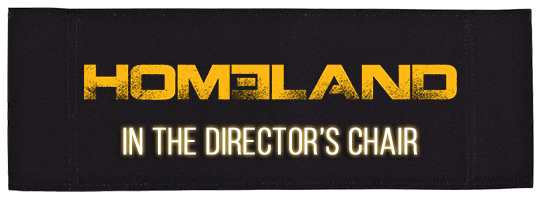
“The English Teacher” | Directed by Michael Cuesta, Cinematography by Giorgio Scali
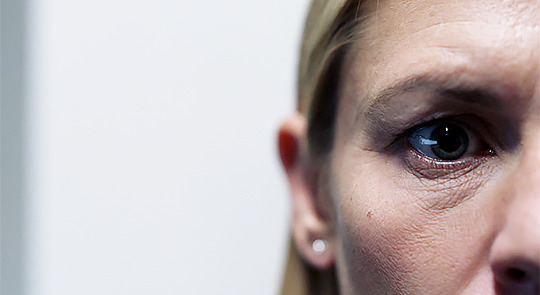
Sara: Not really related to this image specifically, but this week’s episode was directed by Michael Cuesta, whom you may remember as the directing executive producer for the show’s first two seasons. He directed some of the best episodes of the show: the pilot, “The Weekend,” “Marine One,” “The Choice.” I was really, really happy to see that they brought him back for the penultimate episode. That feels fitting and so, so right.
Related to this image specifically, opening on an image of Carrie literally split in half in the frame feels symbolic. She’s being pulled in two competing directions, her loyalty to Saul fighting with her desire to prevent a nuclear war.
Gail: When the episode first started I wondered if she had escaped custody and was standing and waiting to have a passport photo taken like Brody in “The Choice” (again, a Michael Cuesta episode). (My tin foil hat has been all over the place lately!) But then it occurred to me that it’s actually the mirror of the opening shot of Carrie in the first episode this season. The close-ups of Carrie in both scenes have a lot in common, especially that we can only see half of her face. In episode one, the other half of the frame was black and here, the other half is white. I think Sara was right when she pointed out in last week’s Director’s Chair about the transition images at the end of “Designated Driver.” Carrie’s life has always been somewhere in between the black and white.
Ashley: The way this carefully pans down across her face, only to find that she is actually cuffed to the chair, is pretty well-done. We’ve seen her in cuffs too many times this season, and trapped in other ways more often than that.

Sara: This image of Carrie watching the suicide bomb footage on TV really calls to mind the visuals in the opening credits of a young Carrie watching war and terror play out on a television screen.
Ashley: How many times has Carrie seen something awful and life-altering on television? She was in this position in season five when she saw Quinn in the gas chamber. Shocking and devastating and just kinda the life of Carrie Mathison, tbh.
Gail: I agree with both of you, this is a great callback to Carrie in the credits and Carrie in “New Normal.” Carrie’s unconventional methods often come at a high price and this scene is another reminder of that. (And how amazing is Chris Bauer, who plays Carrie’s lawyer?! Sara, he’s even giving you some sweet ‘stache!)
Sara: Love the mustache.

Sara: Tag yourself I’m Wellington.
Ashley: We are all Wellington.
Gail: Pretty sure I’ve been Saul all week trying to get my kids to do their e-learning. I’m tagging my son as Zabel and my daughter as Hayes. My husband is full-on Wellington, knowing I’m right but refusing to get involved.

Ashley: The sharp difference between Zabel’s terrible beard and Saul’s luscious beard is one of the best things this show has offered us.
Gail: I love that Saul’s body language tells a story too. He can hardly bring himself to look at Zabel, let alone face him.
Sara: John Zabel is a real fuckin’ slime ball and Hugh Dancy has been so, so good in this role. You can tell he must relish getting to play this evil character, going up against these actors and actors that he’s known so intimately, though entirely offscreen, the last ten years.
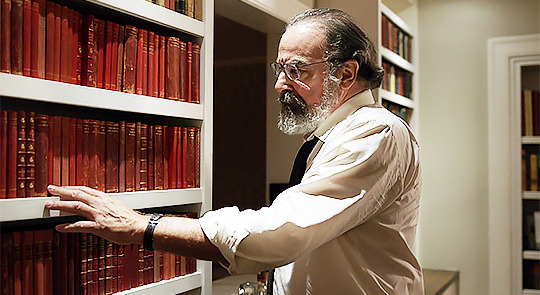
Sara: I love this detail of Saul moving one of his books back just a millimeter or so. It really emphasizes how meticulous he is and also begs the question if he’s going to realize Carrie had them all splayed out on his living room floor. Does he keep them in a specific order?
Ashley: I WAS WONDERING THE SAME THING. And I’m surprised he has so many of them — he was looking at one volume specifically, so I initially was wondering if his commie shelf was just to hide that particular book.
Gail: No small detail seems to escape Saul’s attention. Such a small movement, but it says so much about who Saul is. And yes, Ashley, some of those books were just decoys! Carrie figured that out as she was sorting the books, which is also a great detail about who Saul is. Saul’s red book collection of asset communication is also his hobby. As Carrie says, the best lies have to have truth in them.
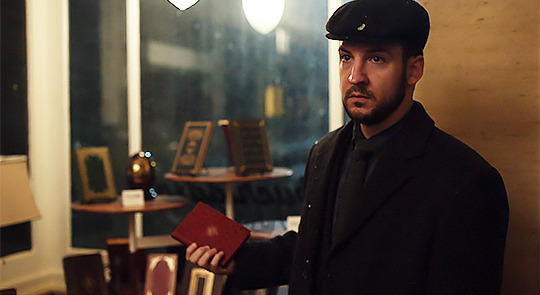
Sara: Ben Savage as young Mandy Patinkin is some of the most inspired casting ever. I know he’s already played a young Mandy Patinkin, but I am still in awe. The flat bill cap was an excellent detail. #hat
Gail: I love how he is wearing a trademark Saul plaid shirt, too!
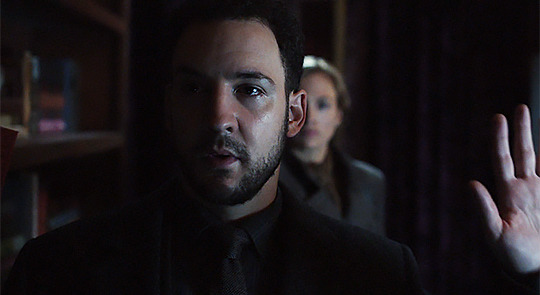
Gail: Another shot of a character with only half of their face shown. This time it’s a young Saul who already has his fair share of secrets.
Ashley: Spoiler alert, she doesn’t shoot him.
Sara: IJLTP.

Gail: We don’t get this close-up shot in this scene until Saul drops his facade and asks her if she’s reading between the lines... He wants to pull a fast one on the useful idiots in the Oval Office and wants her help to do it (ugh, Tasneem agrees!). From a distance, we see Saul in his office somewhere in the West Wing, playing the part of National Security Advisor, but as the camera moves in for this close-up, we see Saul as who he really is: the smart and strategic spy.
Sara: There were quite a few extreme close-ups of Saul this week. What does it mean in an episode where we learn more about his heroic past than potentially at any other time this series? For me this really put into perspective how much we don’t know about Saul. Carrie alludes to snippets he’s revealed over the years, but even she--presumably his closest confidante--doesn’t know. Saul is the opposite of an open book, pun intended.
Ashley: Let’s crack his spine open and see if there’s a note.

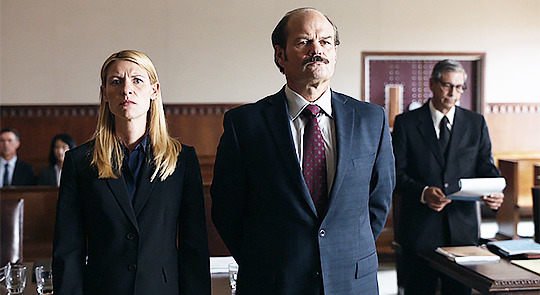

Sara: This slow push on Carrie as the judge reads the list of charges against her is devastating, and not just for Carrie. It is for the audience too, because we know the truth. It goes without saying that Claire is magnificent here.
Ashley: Listening to all of the things Carrie Mathison is being charged with — specifically because we know the character, we have known her for a long time — is painful. For Claire, who has lived in Carrie’s skin for so long, it must have been torture.
Gail: Carrie’s lawyer is dressed in red, white and blue while Carrie is dressed for a funeral. I’m sure neither is a coincidence.

Sara: I do not like the context of this shot, but I love the shot itself. IDNLTCOTSBILTSI.

Sara: Linus being the only one in a room full of military brass and West Wing staff who understands that something’s fishy here is a very “of course” moment. I love how they’re framed in shadows here. In a way, he and Saul have both been running a “shadow” government all season, working in the background, out of sight.
Gail: Saul has his own circle of trust now and Wellington’s circle is only bumping up against it, no Venn diagrams here. Saul is playing his cards close to the vest, knowing he is on borrowed time. (See what I did there?)

Sara: I loved the payoff of the Carrie/Jenna relationship this week. Jenna coming to the realization that Quinn did before--nothing is worth the damage they cause--plays like a terrible déjà vu moment. Carrie just sits there, silent, as Jenna walks out. As staff writer Jonathan Redding said, “She was never going to become another Carrie. She can’t make Carrie’s trades.”
Gail: I think Carrie sits silently as Jenna walks out because she can’t argue with her. Carrie herself came to the same realization back in season four. Interestingly, as Jenna has her realization that nothing is worth the damage they do, Carrie is sitting at a dining room table, just like Quinn was when he had his realization in “Gerontion.” Except this time Carrie is the one who everyone thinks is guilty of a crime she didn’t commit. So. Many. Parallels.
Ashley: Putting Carrie at the dining room table is interesting — she’s surrounded by empty chairs. You can’t help but think of all the people she’s lost, and yet another person is walking away. She’s completely alone.
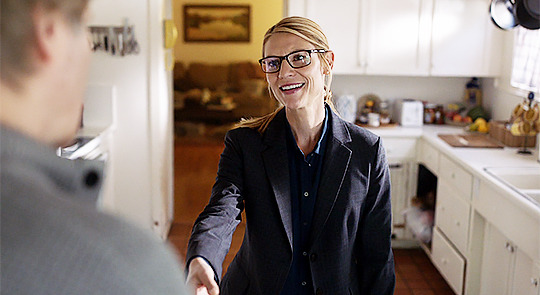
Sara: ICONIC MOMENT IN TELEVISION HISTORY.
Gail: Did Carrie swipe a pair of Saul’s glasses from his house? They look similar to asset Anna’s glasses as well. Not sure if that means anything, but it’s interesting.
Sara: Gail, you can read my tin foil hat theory on that in this week’s TCWTW.


Sara: I love love love this transition that reveals the teacher in the photo is the Russian translator. It’s inspired.
Gail: Me too! I also love that she is in focus while everyone else is not, which adds importance to her character as well. The first shot of her mirrors the photo of The English Teacher. We don’t see her full face until she talks to Saul directly in this scene, a small detail that reveals who her character is important to.
Ashley: Her shoulders are squared, head cocked, listening — the contrast from the girl she was in the photo is evident even from behind.
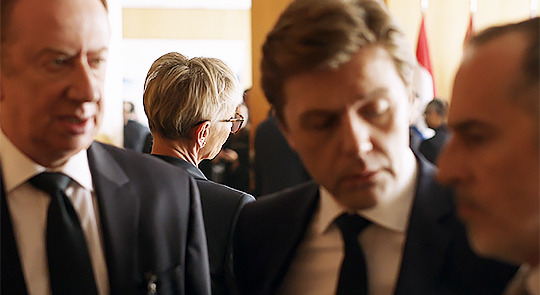
Gail: Usually when a character is having an important moment, you see their face and reaction on camera, not the back of their head. Breaking that rule with Anna over and over again throughout the course of this scene is extremely effective. She’s a faceless, non-threatening fly on the wall and surely not the high-ranking Kremlin (and presumably male) official they are worried about.
Sara: The framing of these characters in this shot is amazing. Anna stands in the camera’s focus, head tilted ever so slightly. The other men don’t even notice. You can see how she’s been such an effective asset. Hidden in plain sight.

Sara: Kusnetsov’s book is Our Mutual Friend by Charles Dickens. This is the last novel Dickens ever wrote, which is fitting here.
Gail: According to Wikipedia, the book explores the conflict between doing what society expects and the idea of being true to oneself. When you set that concept against Andrei’s role as a double agent, the theme takes on new meaning.
Ashley: Nerds.

Gail: Saul doesn’t yet know how important Anna is, but Michael Cuesta and Giorgio Scali are giving the audience a subtle clue here. By shooting Anna from a low angle it alludes that her character is powerful and has influence, something Saul will come to realize shortly.
Sara: We all agree that it was 100% intentional to cast an actress to play young Anna that looks just enough like Claire Danes to make you think, right? I don’t mean that Carrie is the lovechild of Saul and Anna (the timelines don’t match!). More that Saul has a type, no?

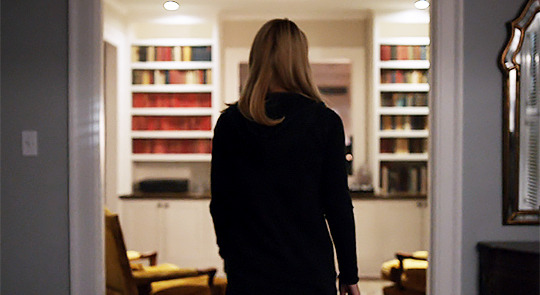
Sara: ...And in case we had any doubt that they’re drawing a parallel between Anna and Carrie, we have this transition. This episode is filled with loaded transitions.
Gail: Carrie in the center of the frame, caught in between the dark and light, is an ongoing theme this episode. We see it here again as she makes her way toward Saul’s library.

Sara: There are multiple pans over Saul’s giant collection of red books, most of the titles unreadable and blurred. But where do we land at the end? The camera holds on this book, A Woman’s Vengeance by James Payn. There is almost no info about this book on the internet, which leads me to believe it’s fake. Yet it’s in the public domain. Did they just like the title?
Gail: I read a little about it online. It was published originally in 1872, volume 2 of 3. I read an excerpt of it on Amazon, and the first chapter is titled “A Good Night’s Work.” Having this close-up shot of these books that follow our introduction to young Anna, Saul’s asset who is clearly a woman scorned, makes this book title (and the title to its first chapter) feel very fitting.
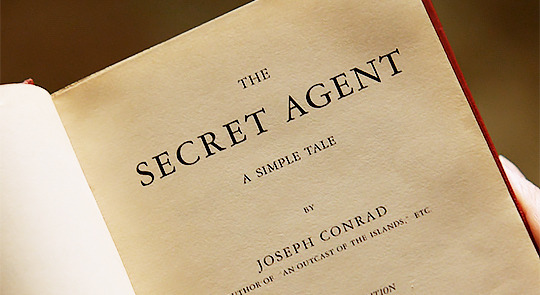
Sara: If the Wikipedia entry about The Secret Agent is any indication, this book is a doozy. Basically everyone suffers and dies at the end and an innocent person is accidentally killed.
Gail: That Wikipedia page is crazy! It also says that Ted Kaczynski, the Unabomber, loved this book and closely identified himself with the character of the “Professor”... which ties into Saul’s alias, Professor Rabinow. I live for this stuff--always a mark of a good production when the depth of the details matches the intensity of the show.

Sara: The phantom horizontal line on the seven.
Ashley: That is like the ONE thing that I, Ashley, actually noticed and mentioned first. Give me a shout-out, man, I mean, DAMN.
Sara: Shout out to Ashley, who noticed and mentioned this first!

Gail: Homeland always gives us the best bokeh. I love its use here. We have a window into Saul’s biggest secret, the details surrounding it are hazy to us at first, and we can’t see the full picture yet--just like this shot.
Sara: IJLTP.
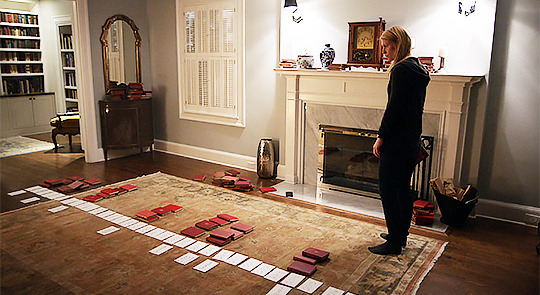
Ashley: I love how old-school Carrie is — she’s so visual, and in her own way, just like Saul. She lays it all out and uses her hands to put it together.
Gail: Her bulletin board, highlighters and thread have been replaced by notecards and old carpet that I’d like to think Mira picked out, but the result is the same as we watch Carrie put all of the pieces together. It’s HIGH RED y’all.
Sara: “High red,” omg. I’m obsessed with the sequence of Carrie assembling the book timeline and figuring out Saul’s method of communication. For me it’s one of the all-time best Homeland scenes.



Sara: The editing in this scene is exquisite. The use of jump cuts adds to the tension and uncertainty as Carrie herself attempts to splice together these disparate clues into something greater, some sort of truth.
The scene is almost completely free of dialogue. Claire has to convey Carrie’s journey to the truth here through only her actions. I love the shots at ground level of her literally on hands and knees flipping through the books. There is a sense of desperation and urgency to it that is thrilling.
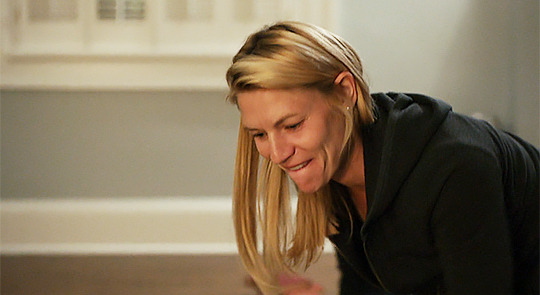
Sara: The Smile.
Gail: I see what you did there and I approve. IJLTP.
Ashley: I’m a little surprised that Carrie isn’t a bit more conflicted here.
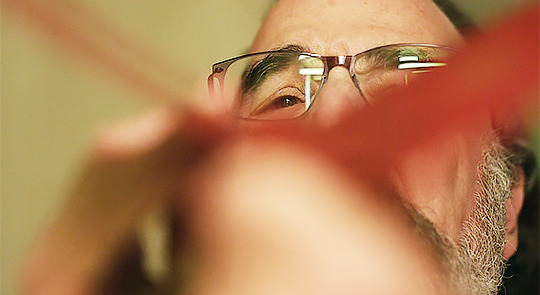
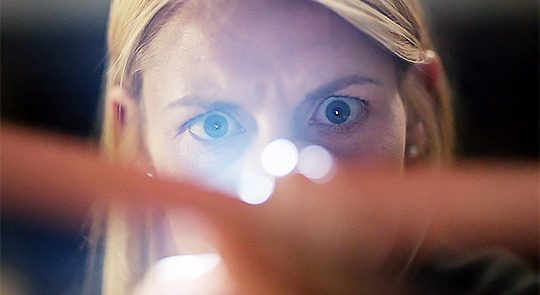
Sara: Cutting Carrie and Saul together at the moment where their minds finally sync is … quite literal, actually, but it works. In these twin shots of Carrie and Saul I’m struck especially by how Saul is against a light background while Carrie is cloaked in darkness.
Gail: These back-to-back shots give the impression that Carrie and Saul are on opposite ends of the same book which rings very true to me. The black and white imagery continues here as Sara points out. We see Carrie just barely ahead of the darkness, looking toward the light.

Ashley: Mandy just does things with his face sometimes and it’s amazing to watch.
Sara: Another extreme close-up of Saul as he realizes that Carrie lied to him.
Gail: Saul’s line from earlier in the season rings in my ears here. “You are vulnerable to him in ways neither of us can imagine.” But to build on my thoughts on his earlier close-up shot, I think it’s an effective tool for us to get a window into what Saul is genuinely thinking and feeling at that moment. The massive implications of Carrie’s involvement in a play being run by Yevgeny are devastating and Saul realizes it in one stunning and heartbreaking moment.

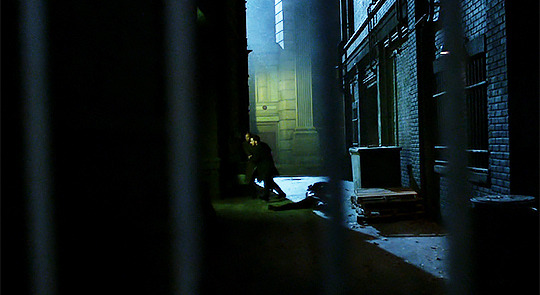
Gail: Anna saving Saul’s life gives so much more weight and importance to who she is to Saul. He owes her his life and, thirty years later, his career, too.
Sara: There is something fantastical about this part of the flashback. The backdrop and extreme lighting looks sort of … fake? It almost looks like they’re on a film set. I’m interpreting this as a reflection of Saul’s memory: we all want to see ourselves as the hero in our movie of our lives.

Sara: Shout out to Gail for realizing this Charlotte Benson character was featured last season with Ivan.
Gail: I love a good easter egg and a good callback. Details like this and recurring characters like Scott Ryan give their world realism. I stan.
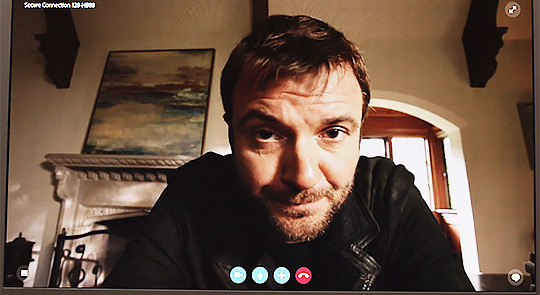

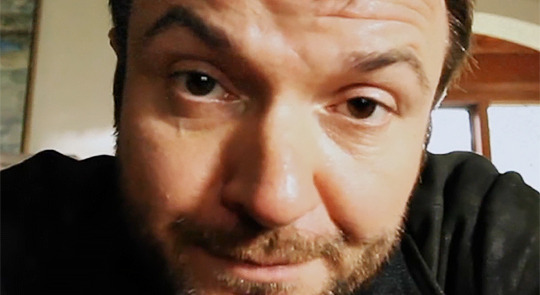
Ashley: This is such a terribly effective moment in the show. We haven’t seen Yevgeny at all in this episode, and yet he’s ever-present; closing on “kill Saul” is so fucking… ugh. Stupid Homeland.
Gail: All of Yevgeny’s shots in this scene are done with a steady camera, which gives the impression (illusion?) of his control of the situation. Have we had a scene where Yevgeny isn’t leaning? My God, he’s even leaning when on Zoom for Spies.
Sara: As Yevgeny reveals the full extent of his play--“Kill Saul”--the camera zooms in on him. Eventually he takes up almost the entire frame. It gives the feeling of stakes being continually raised. And he’s still got that trademark smirk and nonchalance, despite what he’s telling Carrie to do.

Sara: Meanwhile, the camera stays mostly the same distance away from Carrie but pans in semi-circles around her, back and forth, back and forth. It’s an interesting choice as she comes to the realization of what Yevgeny is suggesting. The camera is almost like the wheels spinning in her head as she understands the full scope of the choice she must make.
Gail: As Carrie and Yevgeny go back and forth, each one trying to figure out what the other one knows, the shots start to go back and forth as well, mimicking their dance. In film and television production, there is a term called the 180 degree rule. What it means is that there is an imaginary line running through a scene, from side to side, with respect to the camera. The rule of thumb is that the camera should never cross the line because it causes the viewer to feel disoriented and confused. But when used effectively, we get the powerful effect that it had here in this scene. We (the audience) feel the same disorientation as Carrie, the same unsteadiness that is reflected in the handheld camera that shoots her. As I mentioned above, when we see Yevgeny on the computer screen, he is centered, steady and in control. Quite a contrast between the two.
Ashley: I repeat… stupid Homeland.

Ashley: We’ve seen so much darkness in this episode, mostly related to Saul — Carrie, for her part, has been pretty much in bright spaces. Despite everything that’s happened to her, I believe that this is the darkest point in her life.
Sara: Carrie hurriedly walks out of this vast, empty mansion as the lights dim behind her. The weight and horror of this decision is splayed across her face. The darkness follows her. The question now as we head into this final chapter: can she outrun it? Or will it finally catch up to her?
Gail: Staying just ahead of the darkness and trying to find the light. Here Carrie is again living somewhere in between.
#let's crack his spine open and see if there's a note#zoom for spies#we need alt titles for these now i guess?#homeland#homelandedit#in the director's chair#the english teacher#*#by: sara#by: gail#by: ashley#michael cuesta
6 notes
·
View notes
Text
Ghostbusters: Afterlife - Trailer A Breakdown
“Troy, wondering what you thought about that new Ghostbusters trailer?”
Well, I’ve waited thirty years for this moment. Something tells me that my long-winded and verbose writing sensibilities won’t be able to convey my thoughts in a text message or 140 characters on Twitter. Welcome anyone that I’ve pointed in this direction. I’ve been waiting an awful long time for this. And that’s not to be dismissive of the wonderful experience and entertaining film we received just three short years ago. This is something different. But the same. Something new, but also something familiar. In one word?
Wow.
Quite a bit to unpack in a trailer revealing the first details on what has otherwise been a very tight-lipped production. Needless to say, the first real look at Jason Reitman’s Ghostbusters: Afterlife blew me away. The direct sequel to Ghostbusters II looks to take some twists and turns, while incorporating the iconography and elements that made the original film and its sequel so popular in the 80’s. To be completely honest, it’s quite difficult to sit here and put into words my reaction to seeing a trailer for a movie I’ve been waiting 30 years to see. Excited doesn’t even begin to describe just how fun and exciting this trailer release has been. Not to mention just how special this film release will be.
But you’re not here for a review or my sentiments, you’re here for a breakdown to the trailer with a few comments and screen grabs.
Let’s do it, eh?
Hitting the Road
Right out of the gate, some stunning cinematography from Eric Steelberg on full-display here as a car full of teenage kids approach what appears to be an old mine elevator at the top of an incredible looking vista. Kids being kids, golden hour in full effect, it’s a lovely first introduction to the world in which this film will inhabit. Finn Wolfhard’s character Trevor answers a pointed question that his family has moved to Summerville because they’re completely broke. To the point that he’s getting a haircut at home by his own mother, Callie (played by Carrie Coon). We’re meeting a family on some hard times, forced to make a hard turn in their lives because of finances.
Grandpa’s “Creepy Old Farmhouse”
The family pulls up to a farmhouse and barn that looks like they’ve both seen better days. A giant barn with a collapsed roof and several silos surround a Gothic looking weather vein riddled house that may as well be out of the Addams Family. Dire circumstances have forced them to move to a family farm inherited from an, as of now, unknown grandfather. Phoebe (played by Mckenna Grace) gets out of the car with a look on her face that says it all. And those eyeglasses… well, we’ve all talked about who those look like they belong to at great length.
Something’s Amiss
Trevor’s tender moment with a new friend (Celeste O’Connor’s still as-of-yet-unrevealed character) is interrupted by the mine elevator they’re sitting on shakes violently and a green glow emanates from the mine below them. All is not picture-perfect Americana in Summerville as we’ve been led to believe. An entity explodes from the mine, escaping into the air and pushing the teenagers back in the process. That glimpse of our paranormal haunting kicks us into the studio and production company logos.
Bron Studios/Bron Media Logo
Interestingly, no Ghost Corps logo attached to the trailer. But there is a newcomer to both the trailer and the teaser poster released on Friday, Bron Studios. A Canadian company, Bron gets a logo right after Sony/Columbia possibly suggesting they’re a financial backer of the film or a large partner in some shape or form. A quick look at iMDB shows that Aaron L. Gilbert of Bron Media has been added as an Executive Producer to the film as well.
Earthquakes and Mr. Grooberson
Here’s our first real taste of how Paul Rudd’s character will factor into the film. He’s intrigued by Summerville’s seismic activities, given the fact that it doesn’t lie on a fault line, nor does it have any of the telltale signs of locations that should be moving and shaking. The protagonist family huddles under a table during a quake where we get a good taste of the film’s humor courtesy of Trevor with a quippy one-liner about the summer that they died under a table. So what is happening? Stay tuned. Also, admittedly I was too distracted by the beautiful lighting in the shot with Trevor to notice the symmetrical book stacking visual gag in the background until others pointed it out. Well played, set dec team. I’d expect there will be visual easter eggs like this throughout the entirety of the film.
Mystery Box Revealed
Following one of the quakes at their new home, Phoebe seemingly finds a loose floorboard and a sliding puzzle that has been left behind by their grandfather to hide the presence of a familiar ghost trap. Which Phoebe takes to school and shows off to her still unnamed friend, played by Logan Kim. The sight of a ghost trap tickles Mr. Grooberson, who connects it with the famed-Ghostbusters who saved New York City back in the 1980’s. The kids have no idea of the existence of ghosts, nor what occurred back in 1984 near Central Park. Grooberson is more than happy to educate them.
Jason Reitman Front and Center
After the ghost trap’s appearance, Jason Reitman (deservedly so) gets a card proclaiming the film coming from him as a writer-director hyphenate. The credit comes over an industrial space with a whole lot of Ridley Scott creep-factor going on. If I had one nit to pick with the trailer, it’s the producer in me that is concerned poor Jason’s credit never resolves with the “R” in Reitman not obstructed by the light blooming in the center of the frame.
A Free-Roaming… Something?
Right after Jason Reitman’s card, comes a panning shot across the same industrial space where a gelatinous blob is in the distance doing something. It’s tough to make out exactly what type of entity we’re looking at here, but it seems to appear (and move) like a microscopic organism or something found at the depths of the sea. Which I quite enjoy. A ghost that looks unlike anything we’ve ever seen before. Also worth noting that the movements feel practical - there is weight and almost a rubbery movement to it just like the creature designs from the shop in the 80’s. Love it.
New York Was Like the Walking Dead
Mr. Grooberson shows Phoebe and Logan Kim’s character archival footage from the 1980’s where he remembers seeing the ghost trap utilized as a kid. The Ghostbusters were a phenomenon 35 years ago, but have been forgotten. As history tends to move on and generations aren’t impacted by the events of their elders, they’re learning about who the Ghostbusters were. Phoebe comments that her mother has never spoken of the events that took place in New York and that their father isn’t in the picture.
Of note, these two shots are incredible angles that I don’t believe I’ve seen before. Perhaps the result of Jason Reitman and his post production team digging into the mines and finding the original dailies and negative from the 1984 film for use in Afterlife?
PKE Readings and “Does This Pole Still Work?”
Phoebe seems to have found other Ghostbusting equipment and uses it to trace readings back to a makeshift shed. Presumably a continuation of the scene based on the editing, Phoebe slides down a fire pole (!!!) to a subterranean hidden space. She continues to follow readings on the PKE Meter, finding equipment including the orange piece of machinery taken from the original Ghostbusters at Columbia University, a Betamax recorder in the far distance, an oscilloscope, and a whole lot of fungi growing in jars. The camera pans over sample dishes of spores, molds and fungus collections, (subtly cued with Phoebe talking about picking through the rubble of her grandfather’s life) and then continues past a proton pack in progress of assembly.
Admittedly, this was the first moment in the trailer where I could feel my heart doing backflips. We’re seeing the past through Phoebe’s eyes and everything looks, feels, and sounds like Ghostbusters. I love it. This movie is about discovery, as we’ve heard over and over. To me, it feels a bit like we’re (the viewer - the broader public outside of us fans) are rediscovering our love for what made these movies so popular.
The Shoe Drops
This is where any other trailer would take the opportunity to pepper in the bass drops, kick in the soft-breathy cover version of Ray Parker Jr.’s theme song, or some other overused trope. But Ghostbusters Afterlife takes a pretty bold stance and tries something different. And to me, it really works. When Mr. Grooberson discovers that the ghost trap isn’t a replica and is, in fact a real ghost trap (and may be occupied still), he questions who Phoebe is, as there’s a cut to Phoebe’s hand grazing over a rack of flight suits revealing the name tag, “Spengler” barely having enough time to resolve before a smash to black.
In what is absolutely a stroke of genius of whomever is responsible for this wonderful trailer, Bill Murray’s line for the original movie as Venkman and Stantz share a bottle of Apricot Brandy talking about going into business for themselves takes on a whole new meaning: “Call it fate, call it luck, call it karma. I believe everything happens for a reason,” is said while - - to my ear - - a new rendition of the same Elmer Bernstein cue that plays under the scene swells.
A Certified Genius or an Authentic Wacko
After a “Next Summer” sell card, another beautiful Americana (c/o Calgary) vista of the Shandor Mining Company. Interesting, perhaps Ivo Shandor from the original film fancied himself an entrepreneur at one point before he became an architect? Or perhaps this is a result of his interest in metallurgy mentioned by Stantz? Perhaps he mined his own supplies for projects? Either way, I’m starting to think that Sumeriaville… ahem… sorry… Summerville might be following in a classic trope of some of the best horror stories. A town with an incredibly horrible secret. Warning signs don’t matter to Phoebe and Logan Kim’s character as they trudge ahead.
Hello, Beautiful
Meanwhile, in the narrative of our trailer, Trevor follows in Phoebe’s footsteps into the fields of the farm and finds something of his own: a beautiful (but a little rusty) 1959 Miller-Meteor Cadillac as the ground shakes again, something shatters through a row of school buses seemingly attacking Phoebe, and the town goes into high-alert. Amid the chaos, there’s a striking 20 frames or so of Phoebe staring into a horrifying fire pit of arms - lost souls? Something else? And immediately after that, Mr. Grooberson frantically tries to escape from a snarling beast that slams a foot on the hood of his automobile. Trevor’s Ecto-1 adventure continues as he turns the key and an homage that would make Laszlo Kovacs proud reveals the familiar license plate and front grill emerging from the garage and into the field for a joy ride. The ol’ Ecto has a whole lotta horsepower left in the tank.
Damn Right, This Thing Has a Gunner’s Seat
And that’s when the trailer hits us. What can and should be the most amazing surprise in the trailer (if not unfortunately spoiled for you by a few self-interested rotten apples with horrible cell phone photos) - this isn’t the Ecto we’re familiar with. Perhaps an explanation as to why it’s the ol’ Ecto-1, or maybe the car was always being changed throughout the duration of the Ghostbusters’ longevity, THIS Ectomobile looks to have been heavily modified for field work. Phoebe, with a thrower in her hand, swivels out into an attack position and we’re off to the races. The Ecto-1, with Phoebe in the gunner position, looks to be chasing the microscopic entity seen earlier in the industrial space - though some people have speculated that might be Slimer, I don’t think that’s the case. Either way… Dear Hasbro, take my money now. My goodness, what an awesome set-piece (and toyetic moment) that looks like it will be.
Everything about this movie speaks to me. It’s playing with my nostalgia. It’s also giving us something new and the promise of the next generation discovering the Ghostbusters both on-screen and off. The fact that a main character is named Trevor for some reason immediately made me think of my amazing former boss and now guide to the next generation of comedy Trevor Albert, who was a long-time friend and colleague of Harold Ramis. Phoebe’s an intriguing character and the friendship that we saw Mckenna Grace and Logan Kim develop via social media throughout the course of the production seems to have carried over to their on-screen performances.
Of course, noticeably absent are any of the original cast members. But, as the theme of this trailer and seemingly the movie as a whole is discovery and things slowly unfolding, I can imagine that moment will be saved until the absolute very end of the marketing campaign. If the cast isn’t kept in secret similar to Mark Hamill in The Force Awakens completely. To be completely honest, I don’t want to see another frame until opening day of the film itself. And if this is the only trailer they release, that would be a wonderful mystery box. Particularly for this Ghostbusters podcast host who would have to break another TV spot or trailer down frame by frame. I get the sense that the less we know and see about this movie before the first viewing experience, the better.
But most of all - - the iconography, the designs from Stephen Dane, Michael C. Gross, and so many other artists has carried over successfully and looks authentic. This is no replica, as the trailer blatantly tells us. This is the real deal.
9 notes
·
View notes
Text
Seven (1995)

Few detective thrillers are quite as unsettling or as atmospheric as Seven. It’s an unforgettable, disturbing must-see.
Set in an unnamed city at some point during the nineties, Detective Lieutenant William Somerset (Morgan Freeman) is about to call it quits. After years on the force, he’s retiring in a week. Taking over for him is David Mills (Brad Pitt). They begin investigating a series of strange and cruel murders inspired by the seven deadly sins: gluttony, greed, envy, wrath, sloth, pride and sloth. Meticulously planned and executed, everything points to an intelligent killer determined to finish his gruesome masterpiece.
Through the cinematography, the set design and the mood of every scene, director David Fincher paints a dreary portrait from which everyone wants to escape but cannot. It’s always raining, the streets are gray and dirty and everyone seems either frustrated or bored. I don’t think there is a single shot of a tree or even a houseplant in the entire film. This feeling of dread is perpetuated by little details in the conversations you overhear. In your typical Hollywood movie, the lives of cops seem exciting: chasing bad guys, solving murders, saving victims, getting the girl and all that. Not here. In Seven, the cops feel like real-world officers must on the worst Monday of their lives. They are bogged down with mundane paperwork and annoying distractions. When they go home, they’re tormented by the dead victims and criminals who went unpunished. Somerset describes a mugging in which the victim’s eyes were both poked out with a chilling nonchalant tone that tells you he’s genuinely disturbed, but so worn down he can no longer muster up the strength to be shocked. It makes you wonder what could’ve brought Mills and his wife (Gwyneth Paltrow) to this ring of hell. In this catacomb of filth and misery, do the cops even stand a chance of catching the depraved killer, so in-tune with the vermin that populate it that he must blend in seamlessly?
You might have heard people talk about Seven and the killers’ victims in a way that makes it sound lurid, gruesome or even pornographic. Actually, there is little blood overall, and almost all of the pools you see have been there for a while, they’re not gushing out of severed arms or necks. The key word here is not gory, it’s disturbing. David Fincher knows the mind is the most effective tool so he often only implies or describes the victims’ fates. It’s a good thing, as these crimes are so horrific they would have even seasoned gore hounds running. Instead, the actions of the killer add to the already dreary atmosphere. Interestingly, it creates a strange paradox. On the one hand, the crimes are so cruel that you really want detective Mills and Somerset to catch the villain. On the other, you’re curious to see what kind of sick scenario he has planned next.
It’s not enough that our heroes are pitted against a formidable and fascinating opponent; they also feel like real people. You sympathize with Somerset. Thanks to the mood, you understand how weary he is. You desperately want him to escape. You also like Mills. He’s a hothead but this gives him the necessary drive to persist and gives you hope. Also worth mentioning is Gwyneth Paltrow’s character. She feels real because she’s somewhere in the middle between the two, quite literally. She’s the bridge that makes them become not just partners, but friends. Her role isn’t major, but she provides some crucial moments of humanity in a story that drips with evil.
You might be wary of seeing Seven because of its reputation, but you have nothing to fear. It’s a thriller, not a horror movie. The key is that it’s disturbing. It makes you think and shocks you, but not in a cheap way. It’s wonderfully written and filled with fully realized characters. The direction is masterful in the way it creates atmosphere and gets you to sink into the same territory as the people you follow. It also has a killer of an ending. It’s so perfect you’ll never forget it. Don’t let anyone spoil it; go see Seven right now. (On Blu-ray, August 1, 2014)

#seven#seven movie review#seven film review#seven deadly sins#david fincher#brad pitt#andrew kevin walker#morgan freeman#gwyneth paltrow#john c. mcginley#1995 movies#1995 films#5 star movies#5 star movie reviews#adamwatchesmovies
7 notes
·
View notes
Note
Please could you talk about the weird and specific visual language of person of interest? I haven't noticed it before but now I'm intrigued
Hi, Anon. You sent this ask 8 months ago. I took this long to answer because I wanted to really lay it all out for you, with the right screencaps and reference images and a whole theory of why the show looks the precise way it does. But the fact is, that’s not going to happen. I don’t have the time or mental energy to do it properly, and I have finally accepted that because the almost completely written long-ass answer to a different question about a different show that’s been sitting in my drafts for about as long is still languishing! and it’s almost done! wild what grad school can do to a person.
So since I have accepted that I can’t do the Full Treatment I wanted to, I’ll just do the quick explanatory version.
POI has 5 main visual ideas it returns to over and over. These are:
1. Surveillance footage. This is notable because it tends to look, by normal framing and cinematography standards, bad; they are very deliberately putting out “bad” images to tell the story, which after all is in large part about surveillance and privacy. I can’t remember now where I read/heard this, but the EPs definitely talked about the struggle to get cameras into these really inconvenient spots to get the properly terrible angles that would play as plausible CCTV-type footage.
2a. Edward Hopper’s style. By this I mean less his use of color than his tendency to show one or a few static figures, small in relation to their (usually urban) surroundings, often locked off by a frame-within-the-frame (someone framed in a window within the larger setting, for example); and significant contrast in lighting. The emblematic example for me is the wide shot of John cradling Carter’s body next to the phone booth, right after the moment of her death. But a lot of the comedic exterior shots of a bar or other establishment inside of which John is wreaking havoc actually fit as well.
2b. Noir, which was probably influenced by Hopper in the first place (or at least was responding to similar aspects of the zeitgeist). “POI noir” is a very popular thing in the fandom, and I assume you don’t need me to explain it. I will say, though, that as a film genre noir is about the failure of institutions, loneliness, isolation, and doom, so the choice is both telling and appropriate. (The same applies to the Hopper point.)
3. This is related to 2 and 3, but there is a broader theme of small isolated figures against a big, empty (or sometimes empty by virtue of being anonymously crowded) urban backdrop. (This is something noir does a lot also.) The reason I’m separating it here is that POI does this a lot of the time without making it noir; it creates something lighter-colored, lower-contrast, and more contemporary-looking, but maintins a similar effect. Takeshi Miyasaka’s work evokes it very directly for me. What’s interesting about his paintings as well as these compositions in POI is that they often come off as unstudied, not overthought or excrutiatingly composed. This is not the case; they are very carefully thought out (in both cases). But they convey a sense of naturalism you don’t get from a traditional noir composition (or most of Hopper’s noirish work--some of his other stuff is different, but not relevant here), while maintaining that feeling of a small subject in a big, uncaring, not particularly beautiful world.
4. Comics. POI is often compared to Batman; in some ways it more closely resembles Batman’s even noir-ier antecedent, The Shadow. It obviously leans into this in 4x06, “Pretenders,” but it’s there in a lot of the action sequences. I’d cite the one where John goes after Quinn in “The Devil’s Share,” a lot of “Relevance,” or this as examples.
5. The “interior,” thinking/processing shots of the Machine and Samaritan. For these they obviously invented a lot. They definitely drew on what was at the time cutting-edge data visualization as well as the marketing materials of some leading tech and security companies to create them, but I think it’s one of the ways in which the show was most original. (Interestingly, you can see some of this idea being worked out before the show even began in the movie Eagle Eye, which had the same producers. It’s not a good movie, mind you, and its notion of AI is super simplistic, but some of the visualization in this area is clearly prototypical of what would play out on POI.)
A lot of these visual choices don’t stand out as noticeable (aside from the AI visualizations, which of course are unmissable). There are two main reasons for this. One is that none of them are constant. POI never set out to make every shot a stylistic masterpiece, the way a show like Hannibal more or less did. I assume this was partly because of the logistical realities of a 22-episode season, but it also works with the show’s storytelling. The idea they want you to get, that they reiterate over and over, is that the world looks normal but isn’t underneath. So the 5 stylistic ideas I mentioned above tend to appear in short spurts--an action sequence, a shot framing Harold against a New York skyline or the whole team by a bridge, etc--stitched together by pretty standard TV framing (shot/reverse shot, close-up, medium). This allows them to kind of ramp up and ramp down the level of visual intensity, using noirish or comicky compositions, or particularly intense AI visualizations, in line with the storytelling. It is also a kind of metaphor for the entire premise: things look regular most of the time, but they aren’t if you pay attention.
The second reason is that we are so incredibly used to surveillance footage! It doesn’t stick out to us anymore! This is actually very significant because, as I noted above, surveillance cameras are not positioned for aesthetic value. The point is coverage, not composition or image quality. So this is a cinematic product (a television show) that is working overtime to give you technically “bad” images. But those images don’t really stand out as ugly, per se; instead they denote truthfulness. So for example, the Machine’s POV (as opposed to its thought process, which is digitally animated) is almost always in this surveillance style. This reminds us of what the Machine is and how it works, and it also tells us that what we’re seeing isn’t subjective. It is not someone’s memory or their perception. It is a literal recording. This allows the Machine to act as our guide through the whole timeline, moving us back and forth through that horizontal scroll, zooming in on a moment or incident for replay. We never have to question if the Machine is lying to us or mistaken (aside from 5x02), because its memory is a video archive presented to us with all the hallmarks of video that means “proof,” not video that means “feelings” or “perceptions.” Once we’ve been transitioned into a flashback scene, that style can go away so that we can abandon the distance that surveillance introduces to engage with the emotion of the flashback scene, but they use that device to move us around because it automatically tells us “this is true.” Simultaneously, the ubiquity of surveillance-style shots reinforces that same message I talked about above: that we are being watched (because the world has gone sideways).
(Perhaps I should mention that Nolan and Plageman said a big goal of theirs with the show was to make people more aware of how profoundly the technological and therefore social world around them was changing with little notice or fanfare. One of the obvious ways they were trying to direct our attention on this point was to issues of privacy. Finch helping John out of a sticky situation by exploiting a homeowner’s smart TV isn’t just a matter of making Finch look clever. They wanted to let us know that if your smart TV has a camera, someone can remotely turn it on. [I know this is common knowledge now, but that episode was like 2012. I found out what Palantir was because of POI!] Just to contextualize why to me, “you are being watched” and “the world has gotten very weird” are basically the same message in the context of POI.)
One of the show’s key influences is The Naked City (the show and the film). The film version of The Naked City is notable because it was one of the first post-WWII movies to shoot on location instead of on a film set, and it was shot in NYC. It’s also one of the earliest police procedurals, in the form we know the genre today. It’s not exactly noir, but it’s not exactly not noir. It’s based on the photography of the famous ambulance-chasing, poverty-documenting photographer Weegee; you could say it’s an early example of a “gritty” film. It doesn’t have the elegant devastation of The Third Man or the deep shadows of Double Indemnity. It was all about bringing audiences the amazing spectacle of a real place; the paradoxical insistence on authenticity in cinema goes way back. The Naked City to me is somehwere between noir and cinema verité, and in that sense, POI is true to it as an influence.
26 notes
·
View notes
Text
Marked Up Scripts
My breakdown of the script to shoot lecture:
The benefits of marking up a script seem clear. Whilst it might cost you time, it allows a director to review their screenplay before shooting and plan ahead their shots. It can give a director a good idea of the amount of shots needed, based on the material, without leaving it all to figure out on set.
This is also highly advantageous when creating a shot list (which is pretty much what you’re doing already). Likewise, it’s also beneficial for creating a storyboard.
That’s basically the pros of marking up a script: I think this is a standard practice in filmmaking that is most likely used by the vast majority of directors, so I think it’s a good idea to practice this when possible.
The process of marking up a script is pretty simple – but it is important for me to remember so it’s going on the blog.
What actually is the process?:
Well, first you need a script!

As you can see above, the film lecturer was kind enough to provide a script for the purpose of the lecture. The contents of the cover page were as followed:
Script Title?
Written by?
Draft Number?
Date?
Email Address
We were told to fill in these contents ourselves: to familiarise us with the format I’m guessing. Interestingly the unknown script turned out to be a scene from Clooney classic ‘Ocean’s Eleven’. (But we’ll get to that in a couple pages!).
We had a read through the script:
and were then prompted to think about how we could film this. And after, mark the script with our chosen shots. (As you can see below).

The shots available to us are the standard shots in cinematography: you know, Wide shots, medium shots, Close ups etc.
Except we use the abbreviations to make life a bit easier: Wide shot = W.S, medium shot = MS, close up = CU, over the shoulder shot = OTS, and so on… (I think I’ve added another blog post on the abbreviations)
So, using this invaluable information we can understand the squiggly lines and the numbers and letters atop them on the image above:
Let’s take 1.2W.S for example.
The fist number (1) stands for the scene number. Since this is at the beginning of the script it is aptly scene 1.
The second number (2) represents the shot number whilst you are marking the script. This means you can easily track the number of shots you are implementing, as well as being able to organise shooting schedules very easily.
The W.S is simply the type of shot. In this example, it is a Wide Shot.
The length of the vertical line dropping from the information talked about above is an indicator of the length of the shot. In this example, the shot runs for the full length of the page, so it runs off the page. If the shot was to only to be filmed for a couple lines of dialogue it would be capped with a small perpendicular line when such shot was to be cut.
The zig-zagged section of some of the lines is another indicator: it means wherever the line is as such the dialogue will not be on camera (in regard to the shot type).
Side note: If you look closely enough, you’ll notice a couple of the shots have been repeated. Such as 1.1W.S and 1.2W.S. This just means they are filming two wide shots that cover different content: maybe from a different angle.
Once you have arranged your shots you can put them into a shot list:

As you can see, I chose to include a total of seven shots:
W.S/Master shot
W.S (from a different angle)
M.S (of DR)
M.S (of Parole Board)
M.C.U (of DR)
M.C.U (of Board Member 3)
C.U (of DR)
(I’m unsure if you would include camera movements in this section? Or maybe in a separate note section)
And finally, if you can really be bothered, you can create a story board:

As you can see, the one above is expertly drawn. If your lazy/and or smart you can always employ someone arty to make these for you.
The twist:
I had mentioned before that the script we were given turned out to be from ‘Ocean’s Eleven’. Once we had completed marking up our scripts the lecturer showed us the scene. Surprisingly, the scene only included two different shots: A M.S and a C.U.
Interesting…
0 notes
Text
Smokey brand Movie Reviews: Slide
David Fincher is one of my favorite creators. Dude has punched out great cinema over the years. Se7en, Gone Girl; All his work. Interestingly enough, he got his start in the Alien franchise with Alien 3. I think Fincher could have crafted something great but meddling from the top ruined his film. At the time, he couldn't make the movie he wanted because he was brand new, a stooge put in place to finish a corporate cash grab It's f*cked up because I kind of like Alien 3. I liked the potential it had. I may do a proper review on that flick later in life but this one is about the movie that really made me pay attention to Fincher. This one is about his masterpiece, his magnum opus; Fight Club.
The Great
This is a proper, star-making performance from Brad Pitt. If I recall, his clout was on the rise when he got the role of Tyler Durdan but hat he did with this character was truly something special. Durdan is this chaos given form, this anarchist who seethes with raw disdain for society, just below a smarmy surface. His overt confidence belies a truly horrifying genius. You love this dude even though that voice in the back of your head screams that he is dangerous. Tyler Durdan is one of the best written antagonists I have ever seen and Brad Pitt brings this complex, eccentric, force of nature, to the screen with a realism that is often scathingly unsettling.
The Narrator is very interesting. Fight Club is the visual representation of a grown man, having a complete and total mental breakdown; A fact Norton did not miss. Edward Norton pulls off this performance that degrades over the run time. You see the Narrator deteriorate and it's jarring. Norton imbues this decay with a viscerally desperate, almost manic by the end, energy to a character that starts off so tightly wound. By that closing scene, you're as exhausted as The Narrator and that is testament to Norton's ability, for sure.
Last but certainly not least, Marla f*cking Singer. If there was ever a more accurate presentation of my dream girl, I don't know who it could be. Marla is just this broken, nihilistic, sexually liberated, shell of a person. She's freer in ways that I rarely see in people and it's proper endearing to my f*cked brain. Who else do you get to articulate those nuanced eccentricities other than Helena Bonham Carter? HBC has built a career on the abstract and alienated. Marla was perfect for her and Carter played her perfectly.
This entire cast, man, was absolutely excellent. From Meatloaf's Robert Paulson, to Jared Leto's , and even The Narrator's boss, everyone came through and dropped a tone fitting, scene stealing, performance. Even the extras, one-and-done characters like that waiter recommending to pass on the soup or the detectives who tried to get The Narrator's balls, were awesome.
None of these characters would have been so ably depicted without the outstanding direction of David Fincher. I saw this before I saw Se7en, but after Alien 3 so, going in, I was a little suspect. I was pleasantly surprised by how well put together this movie turned out to be, how naturally it flows, especially considering the context of the narrative. Fight Club probably reads as un-filmable, considering some of the scenes that were captured, so for Fincher to give that much life to the overall plot is a proper masterstroke
Speaking of narrative, the writing in this thing is exception. I mean, some of the dialogue is just ridiculous. The sh*t Marla says, the philosophical nature of Durdan, the way certain situations are framed; It's all brilliant. I mean, who writes, “I haven't been f*cked like that since grade school.” and expects that line to be delivered with a straight face? F*cking outstanding!
Seriously, I can't commend the writing enough. To tell this story, the way it's presented, that script had to have been one of the best in Hollywood for the time. There's no way you pack that much detail in a world without a tight ass focus to pull from.
I love the narrative of this story. Most cats would write it off as little more than a hyper-masculine fantasy or tag on to the very aggressive commentary toward the consumerist mentality of the US, but I just love the underlying exploration of man, having the most violent mid-life crises, ever. I mean, the dude disassociates from reality, bags the girl of his dreams, becomes who he always wants to be, and it turns out he wants to be the greatest domestic terrorist in history! That sh*t is awesome! Fight Club is also one of the most earnest, endearing, love stories I have ever seen. I mean, Marla and The Narrator's entire relationship is doomed going forward, but they had one helluva honeymoon phase.
The fight choreography in this thing is brutal. I love a good martial arts outing but this ain't that. This is raw, punishing, no frills, face pounding. This is the curb stomp you get into when cats are after you for your J's. This is that panicked, adrenaline filled, fight for your life. There are no fancy spin kicks or one-inch punches or knees delivered from helicopters. No, the is only the hard, wet, slaps of fist to flesh and it's glorious.
This movie is gorgeous. The way it's shot, the scene transitions, the composition of said scenes, the cinematography and frame work; All of it is f*cking exceptional. There is just this grim, filthy, haze over this surreal vision and that malignancy grows as the film progresses. That aggressive corruption is as much a character in this film as Marla or Durdan, themselves.
The Verdict
If you haven't guessed by my unbridled praise of this movie, I love Fight Club. It's one of my favorite films, ever. It's influenced how I tell my stories and create my characters. Indeed, I believe that Tyler Durdan is one of the best antagonist ever brought to life onscreen, standing equal to Darth Vader and Ledger's Joker. Fincher is in prime form, crafting a chaotic, fever dream of testosterone, mid life crises, and toxic masculinity, package in a scathing social commentary about materialism and superficiality. As a kid, the dope visuals and pulp brutality shocked me. As an adult, the subtle story telling and great character work enthrall me. Edward Norton is excellent, per usual, as The Narrator but Brad Pitt surprised. Tyler Durdan gave him room to play, to experiment, and show us what he could do. Pitt definitely did that. For my money, though, Marla Singer made this flick. No one but Helena Bonham Carter could have made that role work. Fight Club is chock full of gritty performances, surprising cameos, rich writing, great fights, and raw emotion. This film is absolutely excellent and, while earning the reputation as a favorite to the Hot Topic crowd, deserves to be seen by everyone. The first time you experience this narrative is amazing but, upon repeat viewing knowing what you know. It gets better. I don’t believe it’s a perfect film, it’s not as tight as Alien in some parts, but it’s damn close. Fight Club is a modern classic that should absolutely be seen by everyone, at least once.
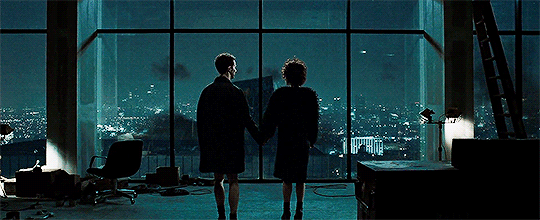
0 notes